Rachael Dickzen's Blog, page 3
January 6, 2021
The Broadway Six Queens Appear in "Ratatouille the TikTok Musical"
All My Six Posts!
Over-Analyzing All the Historical References in Six- “Ex Wives,” “No Way,” “Don’t Lose Your Head”
Virtual Dance Workshops and Q&As with Different Six Cast Members! (includes links to workshop/q&a roundups from Lauren Byrne, Grace Mouat, Natalie Pilkington, Sam Pauly, Cherelle Jay, Vicki Manser, Collette Guitart, Jen Caldwell, and Harriet Watson)
Details from Six Costumer Gabriella Slade’s Instagram Takeover
Six the Musical Wives 1-3: Historical and Modern Costume Inspirations; Six the Musical Wives 4-6: Historical and Modern Costume Inspirations
The Early Costumes of Six the Musical: From Edinburgh to Cambridge to London; Six the Musical Costumes for Broadway!; The Shoes of Six the Musical
The Ladies in Waiting of Six: Historical Inspirations and Costumes; The Tudor Fashion Elements of the Costumes in Six (with Painting References)
The Alternate Costumes of Six the Musical; How the Six Alternates Change Their Styling for Each Queen
I haven’t written about Six the Musical in a while now, huh? I should really finish out that historical references in the Six songs series at some point, lol. As part of my general need to cover everything to do with this Tudor inspired musical, I wanted to share a few quick screenshots from the Six Queens’ appearance in Ratatouille the TikTok Musical!
In case you haven’t heard about it, Ratatouille the TikTok Musical is a tribute to the 2007 Disney/Pixar film created by various users of the social media platform TikTok, with individual people all over the world contributing songs, choreography, costume and makeup design, set concepts, and other elements. Although Disney is notoriously quite protective of their intellectual property, they somehow got on board with this and allowed it to happen, even posting a submission of their own featuring a Disney Channel star on the DisneyParks TikTok. In a statement, Disney said, “We love when our fans engage with our stories and we look forward to seeing these super fans experience the [Ratatouille] attraction when it opens at Walt Disney World next year.”
A virtual benefit performance of the show was staged on New Year’s Day, with Titus Burgess starring as Remy the Rat. Six co-writer Lucy Moss, who also co-directed several of the productions of Six (making her the youngest woman to ever direct a Broadway musical) was tapped to direct it.
I bought a ticket to see the musical on a whim and didn’t actually know too much about it before I saw it; I certainly didn’t realize Lucy Moss was directing it! However, I quickly figured out that Six had something to do with the show, as the entire Broadway cast of Six is in the show! There are also two key tributes to the musical within it.
Here’s how Lucy Moss described the show to the New York Times, “The thing that’s really interesting about the original TikTok materials and submissions is that the aspiration for it was so broad. Despite being on a format on the cutting edge of tech and the most Gen-Z thing in the world, people were aspiring to be like a classic musical. The challenge of doing that in the least theatrical space ever — online — was trying to remain true to that aspiration. The aim is a Zoom reading or an online concert that drank 20 Red Bulls and spit on the screen.”
Someone on YouTube brilliantly put together all the Six portions of Ratatouille the Musical into one video.
All the Six Queens are credited as “Rat Queens,” even though they are really just rat backup singers/dancers and aren’t be queens in the story. This is a clear reference to their roles in Six, which tells the stories of Henry VIII’s six wives in a feminist way. All the actors in Six are referred to as “queens” generally and the Six fandom is known as the Queendom.
The Queens hilariously backed up Adam Lambert as Emile as he sang “The Rat’s Way of Life” with brilliant dancing and singing. A few had short lines as well. They closed out the song with an extremely distinctive pose in which they use their fingers to imitate putting crowns on their heads.

The Broadway Six Queens and swings do the distinctive Crown hands pose.
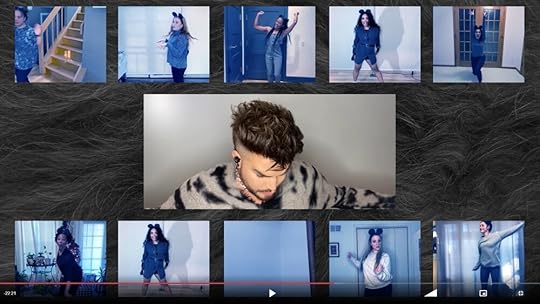
The Broadway Six Queens (and the swings) perform with Adam Lambert as Emile in “A Rat’s Way of Life.”
The Crown Hands appear in the first song “Ex-Wives,” specifically during Catherine of Aragon’s solo (and maybe in a few other places in the show, but it’s been a minute since I’ve watched the whole thing). You can see it in this video of the Six performing at the Olivier Awards at around 2:08.
Carrie-Anne Ingrouille choreographed the musical and was apparently quite the stickler for this pose in particular. When I took a dance workshop from UK Tour Six member Lauren Byrne (blog post here), she said “In the show, it’s horrible because you’re sweating buckets and you don’t want to touch anything to your face – but then the choreographer comes and is like ‘NONE OF YOU WERE TOUCHING YOUR FINGERS ON YOUR CROWN HANDS’ –so she’s really picky about it.”
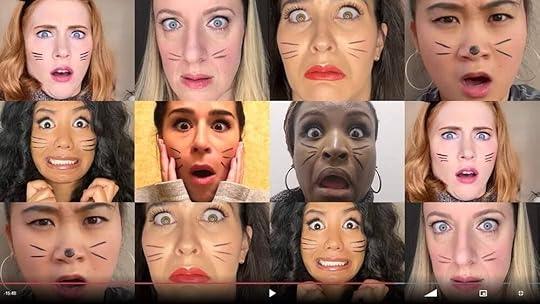
The Broadway Six queens in the scene where Linguini turns on the light in the kitchen and finds rats everywhere.

Remy singing the first line of the first verse from “Ex-Wives” to yell at Linguini.
That looked like the last time we’d see the Six queens in Ratatouille, but fortunately, we were blessed with another cameo in the scene where Linguini turns on the light in the kitchen and finds rats EVERYWHERE. The queens gave us extreme close-ups of their shocked rat faces and it was FANTASTIC.
Finally, the last Six reference in Ratatouille showed up when Remy tries to yell at Linguini after the press conference. He sing-yells “Listen up, let me tell you a story” but is quickly cut off by Linguini. This is the first sung verse line in “Ex-Wives,” the first song in Six, performed by Catherine of Aragon. You can see this at about 1:07 in the Australia cast’s performance of Ex-Wives to the right.
Ratatouille the TikTok Musical was honestly astonishingly good. This was just a one-off one hour benefit performance, but I sincerely hope the rights issues with putting it together get worked out and it actually goes on to become a real full length musical. Even my super skeptic husband said he’d be willing to pay full price to see it in person in the future!
And that’s your random Six update, enjoy. :)
December 6, 2020
Over-Analyzing The Crown: S4E5 Fagan
All My Posts on The Crown
S3: 1 & 2: “Olding” & “Margaretology” 3: “Aberfan” 4: “Bubbikins, 5: “Coup” 6: “Tywysog Cymru” 7: “Moondust" 8: “Dangling Man” 9: “Imbroglio” 10: “Cri de Coeur”
S4: 1: “Gold Stick” 2: “The Balmoral Test” 3: “Fairytale” 4: “Favourites” 5: “Fagan” 6: “Terra Nullius”
The Medals, Sashes, and Tiaras of The Crown
Want to vote for The Crown Fan Favorite Contest? It’s all happening over on my Facebook page!
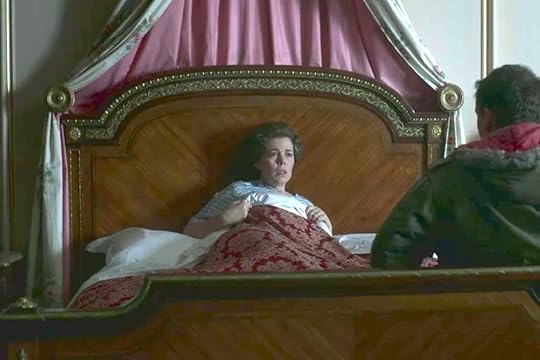
[I really don’t want to make y’all wait any longer for this post, so I’ll add in more photos later this week!]
Since I had great fun over-analyzing every episode of Season 3 of The Crown last year, I’m doing the same thing this year! So if you haven’t watched Season 4 Episode 5 of the Crown yet and don’t want to be spoiled, please stop reading now. :)
The episode starts off with news announcements about Michael Fagan breaking into Buckingham Palace, asking “Is anyone safe?” The Queen watches the TV quietly, in a brown and red paisley outfit. The print is rather confused looking, indicating the Queen’s personal inner turmoil over the entire situation. The announcements end with the thesis of basically the entire episode: “How did he get in, and what did they talk about?”
In real life, we have no idea what they talked about. The Queen has never spoken about it. Fagan has given numerous statements to the press over the years, but his stories have changed several times, so he’s not exactly a reliable witness.
After the credits, the story jumps back three months prior, where we see Michael Fagan waking up in his flat to Thatcher speaking on his radio (he tells her to f off). He walks about his dingy, water-damaged apartment and looks sadly at empty bunk beds and pictures of his kids and their drawings. He wraps himself in a yellow and white floral blanket and stares out the window.
The show made sure to actually shoot all scenes set at and around Fagan’s flat at an actual housing estate that still exists today. The director of the episode noted on The Crown podcast that they really didn’t need to change anything about the estate to match the early 1980s except remove the satellite antennas.
American note: Although estate sounds very grand to many of those outside of the UK, inside England, “housing estate” usually refers to high density, multiple-story tower block public housing. These estates are usually administered and run by a ruling council, as shown later in the episode.
Thatcher is really an ever-present figure throughout this episode. Her voice and stories about her policies show up in Fagan’s apartment several times on radio and TV, play in the background at the unemployment office, and her picture is proudly displayed in the MP’s office. This illustrates the effect of her harsh economic policies on Fagan’s entire life.
The events of this story have been foreshadowed for a few episodes now. Thatcher’s cabinet questioned her economic policies in Episode 2, The Balmoral Test, and The Queen noted the huge rise in unemployment in Episode 3, Favourites. The Falklands War also began in Episode 3, in which it was noted that Argentina entered the war partially to distract from their own interior economic problems. It’s clear that Thatcher is doing the same thing here, as the civil unrest the Queen discussed in episode 3 has now turned to overall patriotic fervor.
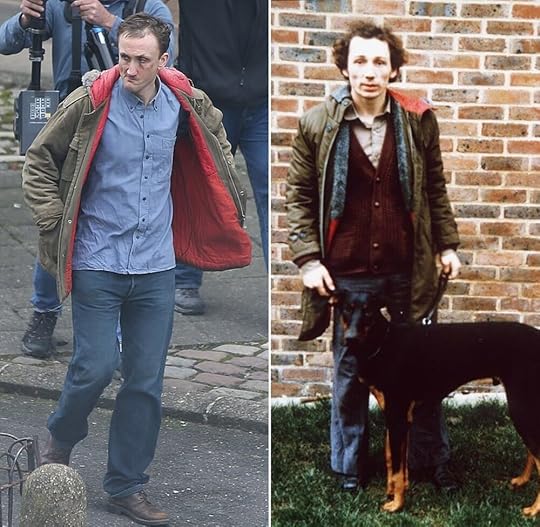
Left: Tom Brooke as Michael Fagan in The Crown.
Right: Michael Fagan in real life.
As he rides his bus past Buckingham Palace on the way to the job center, “Boys Don’t Cry” by The Cure plays in the background. This 1979 post-punk/new wave song likely came out when Fagan was still doing well, living with his wife and kids, and working regularly. The lyrics are very on point here, as the song talks about a man who has given up trying to regain his lost lover and hides how sad he really is. Similarly, Fagan’s wife has left him, but he makes no attempt throughout this episode to try to win her love back; his focus is, instead, seeing his children. The music in this episode is really important, as the songs are almost entirely modern rock/punk songs about male disillusionment and sadness. We haven’t heard songs like this in the show before, as we haven’t focused on a commoner male character before like this, who’s at such an incredibly low point in his life. I feel like the most similar situation we’ve seen to this before is when we saw Princess Margaret breaking down in S2E4 Beryl to “Angel Eyes” by Ella Fitzgerald, but even that is from a specifically female point of view.
Fagan wears essentially the same outfit the entire episode, a distinctive dingy green and red coat over various blue shirts, which looks VERY MUCH like a coat the real life Fagan wore. If you pay attention to this episode, you’ll see that the background in both the estate and Buckingham Palace shows a lot of red and green; the Queen wears a lot of red, green, and blue as well. This seems to illustrate both their similarities and their differences.
The job center is super crowded with long lines of people who look similarly tired and dispirited. He’s here to collect his jobseeker’s allowance, which is available in the UK to adults who are unemployed and actively seeking work. To get the benefit, the jobseeker must appear at the center in person every two weeks to certify that they are still actively seeking work. This is actually still the policy in the UK, but because of the Covid-19 pandemic, those receiving jobseeker’s allowance have been excused from sign on attendance since March 2020.
Fagan gives a lot of cheek to the woman at the job center about how she asks him the same thing every two weeks and how she should know who he is now, but tbh, I just feel sorry for her. She probably deals with hundreds of people a day and couldn’t possibly remember them all. It is a bit ironic that he jokes about how he worked with the Olympic Committee and the United Nations, as that is TOTALLY the type of people we would normally see on The Crown. This intense focus on the real world away from the royals and the top echelons of power is new to the show, except for a few episodes that focused on specific disasters affected the common people, like the smog in Season 1 and the Aberfan disaster in Season 3.
The rest of Fagan’s day is dedicated to working a “cash in hand” job painting a room, where he quips that the paint color “beige 28” is the color of his life. Conveniently, he’s wearing a beige shirt when he says this. Afterward, he goes to a pub, where he clearly is looking out for his wife. He tries to talk to her about their flat (we find out later that she’s the listed tenant on the flat, so he can’t get any money to fix up the flat without her involvement), but she brushes him off, saying tonight. She also brushes him off when he asks about the kids. This brush off frustrates him and he takes out his anger on her new boyfriend, calling him a Twat. His wife and her new boyfriend both throw the fact that the new guy works for a living and looks after his kids in Fagan’s face, which angers him even more. who taunts him by saying he’s the one who’s caring for Fagan’s children. This almost escalates into a fight, but bystanders manage to pull the men apart before they actually come to blows.
This sequence ends with the ska song “Monkey Man,” a cover by The Specials (originally by Toots Hibbert of Toots and the Maytals). A Monkey Man, according to the Oxford Dictionary, is “a weak or gullible man, especially one subservient to women generally.” This ties in with Fagan’s feelings of helplessness about his life, particularly when it comes to his family. The songwriter has said that the song was actually inspired by a girl he loved who left him for another man, which is…very on point for the situation.
The shots of Fagan’s housing estate, complete with bars at the windows, switch quickly to the metal Buckingham Palace gate - once again juxtaposing the upper class royal setting of the Palace with Fagan’s lower class, realistic life. The director of the episode said on the Crown podcast that he really wanted to make it clear when the episode was in “Faganland,” quipping that Faganland is also known as “real life.”
In the Queen’s regular audience with Thatcher, Thatcher’s in her power blue color and the Queen is in a lighter blue (once again matching Fagan’s usual colors- this will happen throughout the flashback in the episode). Thatcher brags a lot about the war in the Falklands.
In the next scene, the Queen and Philip are walking to an event together (past some bright yellow flowers that are reminiscent of Fagan’s sad yellow floral comforter), and Philip notes that they should “roll out the red carpet” for Margaret Thatcher, as she pushed ahead with the conflict in the Falklands even when no one else supported it, and it’s turned out to be a huge success. “She’s finally doing what we’ve been waiting years for someone to do …lead this country firmly and decisively after years of incompetence and mismanagement.” The Queen also complains that Thatcher brought up palace security again, which angers her, saying “Do you want our walls to be built even higher? Or the public to stand ten feet further back at engagements.” This foreshadows Fagan’s break-in to the palace while also establishing the theme of the Queen’s need to meet regular people.
The Queen says, “I take great pleasure in meeting members of the public and have learnt so much from them. You remember the lesson Lord Altrincham taught us.” They meet up with Princess Margaret and the Queen Mother at a Garden party, where they meet “regular people.” This hearkens back to S2E5 “Marionettes,” in which Lord Altrincham criticized the queen in his newspaper and advises her to become more transparent and inclusive of regular people. The Garden Parties replaced debutante presentation parties (which were only reserved for the very rich and noble) and are still held three times a year at Buckingham Palace and once a year at the Palace of Holyroodhouse in Scotland (although they were cancelled this year due to COVID-19). You can see that the Queen IS really trying to reach out to her people, but as becomes apparent throughout the episode with the juxtaposition of her life with Fagan’s, she’s still incredibly out of touch with the lives of regular Britons. It’s also rather funny that they all put on gloves before shaking hands with the regular people, as if they don’t want to actually touch any commoners.
Princess Margaret cares far less about meeting regular people than the Queen and specifically checks with Martin Charteris that they don’t have to have actual conversation with anyone. Margaret’s dislike of the whole thing was also demonstrated in the earlier S2E5 episode, in which Margaret complained to Philip about meeting commoners. In that episode, we also saw that the Queen Mother didn’t particularly like the idea either, but she is silent here. Ironically, Margaret wears drab green and red, matching Michael Fagan’s outfit most closely, but I think the use of the colors is juxtaposed to show their differences here, not their commonality. The royal band is also wearing red uniforms and green hats, which again, matches
The lines of colorfully dressed, respectable, happy commoners at the garden party eager to meet the royals contrasts sharply with the drab despair of the unemployment line at the job center. Thatcher’s voice echoes over the radio in the background (in a distinctly dystopian way, although this of course, is just from a radio broadcast); she’s talking about her up-bringing “we were taught to work jolly hard. you were taught to improve yourself. you were taught self-reliance.” This is a pretty tone-deaf message when there are clearly no jobs to be had for so much of the country. As Fagan said in an earlier scene, everything in here feels pretty beige and dull and dreary. Fagan is again back here to collect his check, and quips sharply to the worker that he works as james bond, who (quite rightfully, in my opinion), calls him a twat. He asks who he can complain to, and she says he should go contact the MP, who can contact the parliamentary ombudsmen. This is ultimately the comment that sets his whole plot in motion. The worker then shuts the window in his face, which seems symbolic of a lot of the bureaucratic obstacles he’ll face in this episode.
We get another shot of Fagan in his sad, empty apartment, watching footage of a military parade on TV and listening to Thatcher speaking on the radio, defending her economic policies again by describing her actions as some sort of tough life.
Fagan’s next at his MP’s office; he’s waiting for him to arrive because frankly, he doesn’t have anywhere else to go. He tries to talk to the MP “about the system,” calling it “unfair and a disgrace.” He calls Thatcher “devil woman” and complains that he doesn’t have any work to do because she’s spending money on the war instead of using it to build houses he could paint and decorate. The MP seems rather stand-offish from the beginning, insisting that he supports the war and not really listening to Fagan’s concerns. Fagan lays out his central frustration in a simple question: “Why would you spend over three billion pounds on a war against total strangers rather than looking after your own family?” This points to his views of the country as a family and as its responsibilities to its citizens.
Fagan calmly points out that the MP hasn’t actually noted his concerns, and hasn’t taken any notes the entire time, and ultimately forces him to write down /something/. Fagan says that having Thatcher’s picture in the office makes it feel like “we’re in turky or iraq,” which adds to the previous dystopian like feel of Thatcher’s voice over the unemployment line.
Finally, in frustration, after a few minutes of arguing about the workings of democracy, the MP tells Fagan that the Queen has a private audience with Thatcher every Tuesday and quips, “Why don’t you drop in at Buckingham Palace and tell her? “
And we’re back to the Trooping the Color, which we saw previously in S4E1 Gold Stick. This shows the passing of time, the Queen taking the salute from her troops (which we’ll circle back to later), and refers to various lucky members of the public getting to attend the event, again illustrating the royal family’s attempts to connect to the public and ultimate failure at doing so.
Then a sharp cut from the “regular people” at the trooping the color, sitting in rows watching the event, to people waiting in rows at the social services office. Again a cut from bright outside light and music to a drab, dreary office setting. Fagan’s in a terrible situation here, we find - as Social Services won’t let him see his children until he fixes up the water damage in the flat, he can’t get money or help to fix the flat from the Council or social services because he’s not listed as the primary tenant on the flat, and his wife, who IS the primary tenant of the flat, won’t talk to him about it (as we’ve already seen happen in the pub). So he’s completely prevented from seeing his children at all. The office worker tells him he needs to talk to the estate council, but as Fagan has already told him, the council pointed him to social services, so he’s left without anyone to help him.
On his way home on the bus, he passes by Buckingham Palace and abruptly gets off, looking up at the palace through the barred gates. He then manages to get in by jumping over the fence, climbing up a drain pipe, and crawling through an unlocked window. He sees a few guards but manages to avoid them pretty easily. He then basically just wanders around the palace, trying various door handles and even sitting on the throne at one point. He enters a room full of gifts (notably with a portrait of the queen there, staring at him) and downs half a bottle of wine pretty quickly, managing to knock over a vase in the process. He manages to get into the Queen’s bedroom, but it’s empty. Eventually, a maid sees him and rushes to the security office, sounding the alarm.
Fagan really did sit on the throne. He said in an interview with The Independent in 2012, “It was like Goldilocks and the Three Bears; I tried one throne and was like 'this one's too soft'. I was having a laugh to myself because there was one right next to it, so I tried another.”
The creators of this episode said on The Crown podcast that it was kind of unbelievable how easy it was for Fagan to get into the Palace, and that if it HADN’T happened in real life, no one would believe it.
If you’ll note, the carpet throughout Buckingham Palace is red, calling back to Philip saying they should roll out the red carpet for Thatcher.
Fagan wasn’t the first intruder at Buckingham Palace. A young teenager named Boy Jones repeatedly broke into the palace to stalk Queen Victoria, stealing the queen’s underwear and food. He kept breaking in even after being imprisoned for three months, and eventually was deported to Australia.
The entire sequence where Martin Charteris reports on the break-in to the Queen and Philip is pretty funny. Philip laughs at the intruder’s drinking a bottle of wine valued at six pounds. Philip is also very proud of remembering the vase that was broken, describing it as “a ghastly little pink thing with little blue worms all over it” and “a strange-looking duck.” The Queen quickly corrects him by noting the exact symbolism of the vase, naming the rivers of guyana and the national bird present on it, which is pretty damn impressive considering how many gifts she must receive every year. Her private secretary looks at her with pride over her recall of these little details.
The Queen (in drab green again) asks Charteris to keep the matter away from the Home Office, as she still doesn’t want her security measures raised. Her concern is “Buckingham Palace is too like a prison as it is.”
Fagan manages to make his situation worse when, after watching his kids play on a playground with his wife’s boyfriend, he jumps over the playground wall and tries to speak to his wife. The wife and boyfriend quickly motion the kids away, which seems only to enrage Fagan. The fight that almost happened at the pub earlier in the episode now actually happens on the playground, resulting in the boyfriend putting Fagan in a chokehold. Fagan leaps back over the wall (similarly to how he got in and out of Buckingham Palace the first time) and runs away, as his wife yells “Are you proud of yourself? Leave us alone. We don’t need you in our lives.”
The incident at the playground results in a meeting with social services, who says Christine will have permanent custody of the kids and Fagan can’t have any contact with his kids, for their best interest. He doesn’t say anything in response but just looks distraught.
What do they know about Fagan that we don’t? Do they perceive him as dangerous to the children? I really haven’t found much information on Fagan’s family life. All the sources seem to confirm that his wife Christine had left him, taking their four children with her, but I can’t find any explanation of why.
After the fight, “Twenty Four Hours” by Joy Division” plays in the background, specifically - the lyrics “A cloud hangs over me, marks every move Deep in the memory, of what once was love.” This very sad song, which was recorded just over a month before the band’s frontman Ian Curtis committed suicide, talks about everything in the singer’s life slipping away from him.
In real life, Fagan was much more of a piece of work than he’s portrayed as in the series. He complained about his portrayal in The Crown, saying that they made him appear ugly and uncharismatic, but I’m really not sure why, as they actually made him appear sympathetic. In reality, he actually visited Buckingham Palace 12 times in the summer of 1982 and told his mother that he was visiting his girlfriend “Elizabeth Regina,” indicating a far more intense obsession with the Queen than was shown in the episode. Fagan himself told the Independent in one article that he couldn’t find a bathroom and ended up peeing on the corgi food. After his first break in to the palace, he actually was arrested for stealing a car (he was apparently trying to drive to stonehenge in search of his wife. was his wife in stonehenge? i don’t know. maybe it made sense in his head). He also claimed that the entire decision to break into the palace was the result of a prolonged reaction to taking too many hallucinogenic mushrooms several months before.
After the devastating social services meeting, Fagan returns to TV reports showing that the UK has won the Falklands war. Notably, the news reports that the queen has returned to Buckingham Palace. He looks out from his balcony incredulously, as all around his estate, people are celebrating the victory in the Falklands, singing “Rule Britannia” and chanting “Maggie Maggie Maggie! Oi Oi Oi!”
Next we see the Queen going about her evening in a very prosaic series of scenes. She watches the news eats dinner alone while wearing green, then gets ready for bed, wearing a blue and white floral robe and matching nightgown. We notably see her praying at her bedside; her faith hasn’t been discussed much in Season 3 or 4, nor has it really been addressed much since Billy Graham’s appearance in S2E6 Vergangenheit, but little moments like this do remind us that she is a Christian and takes her religion quite seriously.
Meanwhile, Fagan breaks into the palace again, somehow avoiding guards as they change shifts and breaking a window to get in.
In the show, a maid walks past carrying a vacuum and later is shown vacuuming the carpet. I’ve seen people complain on Facebook groups and such that this is inaccurate, as there are some reports online that housekeepers are not allowed to use a vacuum in Buckingham Palace. However, The Atlantic reported that Buckingham Palace had a vacuum cleaner as early as 1902, which seems to contradict that report. In addition, The Crown actually has their own royal protocol advisor, Major David Rankin-Hunt, who worked for the royal family for 33 years. He’s very active in the show and often corrects things on screen that aren’t accurate for the royal household, like folding in people’s pocket flaps and making sure their umbrellas are wrapped tightly enough and such. Since the vacuum cleaner is literally a plot point in the script (as it keeps the maid from hearing the Queen’s bell), I find it really hard to believe that Rankin-Hunt would overlook such a big thing if vacuums were really banned in the palace. It’s hard to know though.
The floral floor-length nightgown matches Fagan’s description of her outfit in real life: “Her nightie was one of those Liberty prints and it was down to her knees." This refers to a clothing brand called Liberty known for using floral prints.
As Fagan enters the queens’ bedroom, the queen sleeping says “morning bobo.” This refers to the Queen’s long-time dresser, Margaret “Bobo” Macdonald” who actually served her first as her nanny (which reminds me very much of Queen Elizabeth I’s relationship with her governess Kat Ashley, who rose to become her chief lady in waiting). We saw Bobo in the background a few times in Season 1 and 2, but the IMDB cast list for the show doesn’t show anyone playing that role in Season 3 or 4.
The darkened bedroom looks much more like the scenes we’ve seen of Fagan’s life this episode than the royal family scenes, which have all been in very bright rooms or outside in bright sunlight. Fagan actually seems to blend into the background as he moves about initially.
It’s been really confusing trying to sort out all the different stories about this that Fagan has given over the years, so I honestly just started to look at the police report to figure out what happened.
The police report from the time said that Fagan initially got into the palace by climbing over the railings and entering an unlocked window to a room which housed “the Royal Stamp Collection.” All the doors in that room were locked, so he quickly left it through the same window. He then climbed a drainpipe to get to the roof, took off his sandals and socks, and climbed across a narrow ledge to get through an unlocked window in an office of the master of the household which had just been opened for the day by a housemaid. He wandered around the palace for 15 minutes or so without being challenged by anyone. *In the show, the window was locked the second time and he had to break it to get in.
The police report notes that Fagan claimed to find his way to the queen’s apartments by “following the pictures.” In an anteroom of the bedroom, he smashed a glass ashtray and brought it with him, intending to slash his wrists in front of her. AGAIN, the show clearly makes him seem much more sympathetic than he was in real life. In the show, his bleeding hand is the result of his breaking the window to get in, rather than breaking an ashtray or slicing his own wrists.
In both real life and the show, Fagan opened the curtains upon entering the bedroom. In the show, he prevents her from calling for help, but in real life, she immediately pressed the night alarm bell (this is about 7:15 am). This unfortunately, occurred right after her police sergeant (who’s in the corridor at night) had just gone off duty; this is reflected in the show when Fagan says that there isn’t any officer outside of the room. There were a few servants on duty already. However, the footman who was outside walking the dogs and a maid was cleaning in another room with the door closed. Thus, no one actually noticed the night alarm bell at first. In the show, the maid doesn’t hear the bell due to the sound of the vacuum.
The Police report (which notably doesn’t say what Fagan is doing during this time) notes that the Queen next used her bedside telephone to ask the palace telephonist to send the police to her bedroom. The telephonist called the police lodge at 7:18 am. At 7:24, the Queen called again for help, as a police officer still hadn’t arrived. She eventually elicited the help of a maid, who helped her usher Fagan into a nearby pantry on the pretext of getting him a cigarette. At this point, the footman returned from walking the dogs and helped keep Fagan there by supplying him with cigarettes. The Queen “kept her dogs away as the man was getting agitated.” Eventually, a police officer arrived, and then another, and they took him away.
The show’s depiction of events diverges sharply from real life at this point. In the episode, the queen and fagan talk for a bit until she points out that he’s bleeding. As he goes to the powder room to clean up his cut, she rings the alarm bell, without any response. She tries to pick up the phone, but he comes back in the room before she can actually call anyone. They end up talking for several more minutes before a maid comes in with the tea and asks the queen if she’s alright (Major kudos, by the way, to the maid, who somehow doesn’t scream or drop the tea or anything). The queen responds calmly, “Yes, quite alright. But you might ask the policeman to come in."
The show DOES reference the whole cigarette trick by having Fagan ask the Queen for a cigarette.
I actually honestly wish they had followed the real life story a little bit closer, as I would have loved to see the queen trick Fagan into going to a pantry and protect her dogs from him. This show ALWAYS needs more corgis, In My Opinion.
The little scene between Fagan and the Queen in the bedroom is very well written and very sad. He says he wants to talk to her about what’s going on in the country, and that she hasn’t any reason to fear him. I’m not going to analyze the substance of their conversation too much, but it’s a really beautiful scene that ultimately brings out the queen’s compassion and sympathy for his plight. He begs her to “save us all” from Thatcher and says that she can actually do something. However, as we’ve seen emphasized throughout this show, the Queen really doesn’t have any power in political situations like this and can’t really do anything to help him besides talk to Thatcher, which ultimately does nothing.
Fagan comments that the palace is somehow “posher than you’d think but yet more run down,” as it has chipped paint, peeling wallpaper, and stains everywhere. He made a similar observation in an interview, stating, “It was very ordinary. I don't think they spent too much on decoration. Maybe it was due a redec?"
Within the scene, Fagan shows off his intelligence, noting that the palace is actually public property and that trespassing isn’t a crime if he doesn’t steal anything. At the time, trespassing was a civil offense, not a criminal one. He was not charged with trespassing, apparently to avoid having the queen come and testify against him.
There’s a very funny moment where Fagan says that Thatcher will put the Queen out of a job next; the queen dryly responds “Let me assure you; she is in an all too committed monarchist,” perhaps thinking of Thatcher’s obsequious curtsies to her.
The Queen tries to reassure Fagan by saying “Countries bounce back. People do. Because they have to. One of the most well crafted lines has Fagan saying, “First the work dried up, then my confidence dried up. Then the love in my wife’s eyes dried up, then you begin to wonder you know, where’s it gone, not just your confidence or your happiness…(trails off). They say I have mental health problems now. I don’t. I’m just poor.” As he continues, the Queen sits across from him naturally, a subtle reference to her regular audiences with the prime minister.
The Queen ultimately ends up connecting with him and slightly defending him from the officers. Their conversation ends this way:
Queen: "Is there anything else you'd like to say to me?"
Fagan: "No. Thank you.”
Queen: "I do hope they don't make things too difficult for you, in light of all this."
Fagan: “Thank you."
Queen: "Well, goodbye." (Fagan stands and reaches out his hand to shake hers)
Officers, barreling through the door to come help: "Don't touch her!"
Queen: (to officers) “It's alright.” (she shakes Fagan’s hand) “I will bear in mind what you've said."
The handshake with Fagan, with bare hands and no pretense, thematically ties back to the earlier handshakes at the garden party, when everyone was wearing gloves and on their best behavior.
Olivia Colman does a great job of looking absolutely petrified of him initially, but in usual queenly fashion, quickly regains her composure as she speaks to him calmly. Her fear is only again evident at the very end of the scene, when after Fagan is taken away by the police and she’s finally alone again, she falls back into her chair, gasping and eyes tearing up, looking completely drained.
Then we’re back to where the episode started, with the news reports about Fagan’s break in. Margaret Thatcher watches the news with several stone-faced advisors, looking very distressed.
The episode makes it look like the final days of the Falklands War happened right when Fagan broke into Buckingham Palace, but that’s not quite true. Fagan’s first break into the palace was in early June 1982 and his final entry was on July 9. The British managed to retake all the islands on June 20, a few weeks earlier.
I’m really not talking about the war too much because I honestly don’t know much about it and I don’t want to be run out of Argentina in the future if I get something wrong. However, I do want to note that although Thatcher said in her first audience in this episode that there were no British casualties in whatever specific operation she was talking about, there were actually casualties on both sides of the war. Casualties included 255 British service members, 3 female British civilians of the Falkland Islands, 633 Argentinian service members, and 16 Argentinian civilians. The servicemen on both sides came from several branches of the military, including the Army, Navy, Marines, and Air Force.
The Queen does try to speak to Thatcher about Fagan, noting that he is a victim of unemployment and economic problems, which are not his fault, but ultimately is unsuccessful. Thatcher describes the high unemployment as “a necessary side effect of the medicine we are administering to the British economy” and dismisses the Queen’s questions of moral economy by saying, “If we are to turn this country around, we really must abandon outdated and misguided notions of collective duty.” *NOTE: I am only talking about the portrayal of Margaret Thatcher in this show; I have not done in depth research into her real life views on people. I do plan to read her biography in the future and go back and supplement these posts then, but unless I actually say “in real life” or something equivalent, I am always talking about the characters in the show and not the real people.
This line demonstrates that in her own way, Thatcher does care about the “common man” as much as the Queen, just in a very different way. When the queen notes, “Perhaps not everyone is as remarkable as your father,” Thatcher stoutly responds, "Oh you see, that is where you and I differ. I say, they have it within them to be." When the Queen brings up Fagan, Thatcher notes that he’s another matter, as he’s been diagnosed with mental illness and schizophrenia. She then quickly excuses herself, as she needs to go to the victory parade (which the Queen was notably not invited to).
This scene is set up to emphasize the distance between the Queen and Thatcher in these audiences, which is the same it’s always been, but looks further apart then ever, when compared to how close the Queen sat to Fagan during their conversation.
Later on, while watching the victory parade on the television with her husband (both of them dressed in similar shades of brown and grey), Elizabeth comments on Thatcher taking the salute from the troops instead of the sovereign. This did happen in real life and raised some eyebrows at the time. In 1945, after World War II, King George IV took the salute from the troops rather than Winston Churchill.
As the royal couple talks comfortably, Philip refers to Fagan as a lunatic and a fool. The Queen counters, “but in the best sense, like Lear’s fool.” Philip responds grumpily “Don’t get all Shakespearean with me.” This is a reference to a character in King Lear, which has a couple of interesting layers to it. In the time of Shakespeare, leaders often had fools, or court jesters, to amuse them. They played an important role though, as they are able to speak truth to power and confront their leaders in ways that no one else can. In addition, fools in that time often had mental illnesses, and were considered blessed by God. Within King Lear specifically, the fool serves as the king’s advocate but also his conscience, critiquing Lear’s faults. All of this is a very apt description of Michael Fagan, who has a mental illness and simultaneously served as the Queen’s advocate and critic.
We have one of the first really emotional moments this season from Philip when his face breaks apart a little and he says, “I’m sorry that I wasn’t there to protect you. I feel terrible.” The Queen reassures him in a very loving way, saying “but you're by my side all the time and do much more than keep me safe. but thank you.” They then exchange another quietly funny moment, as she observes, “I suspect Mr. Fagan is rather glad he didn't come through that window and land on your bed.” Philip laughs quietly and responds, “Yes, that would have been a rather different conversation.”
The show ends with a final look at Margaret Thatcher on the TV screen, waving happily to the crowd at her victory parade. The Queen looks at her with clear concern.
The credits run to the 1980 ska song “Whine and Grine/Stand Down Margaret” by The English Beat, which is specifically about the band wanting Margaret Thatcher to resign. At the time it came out, Uncut magazine described the song as “polite insurrection set to uptempo reggae and African hi-life guitar,” which is flipping amazing.
As the explanation in the credits says, Michael Fagan was committed after his arrest. He only spent three months in the psychiatric hospital. The second photo in the credits shows Michael Fagan saluting alongside four men; they don’t explain this in the show, but this actually shows Fagan with The Bollock Brothers. Fagan recorded a cover of The Sex Pistols’ “God Save the Queen’ with this punk band in 1983.
Over the years, Fagan has continued to distinguish himself with various petty crimes. He was notably imprisoned for four years in the late 90s after he, his wife, and their (now-adult) son were charged with conspiring to supply heroin. He lives in London now,
Over-Analyzing The Crown S4E5: Fagan
All My Posts on The Crown
S3: 1 & 2: “Olding” & “Margaretology” 3: “Aberfan” 4: “Bubbikins, 5: “Coup” 6: “Tywysog Cymru” 7: “Moondust" 8: “Dangling Man” 9: “Imbroglio” 10: “Cri de Coeur”
S4: 1: “Gold Stick” 2: “The Balmoral Test” 3: “Fairytale” 4: “Favourites”
The Medals, Sashes, and Tiaras of The Crown
Want to vote for The Crown Fan Favorite Contest? It’s all happening over on my Facebook page!

[I really don’t want to make y’all wait any longer for this post, so I’ll add in more photos later this week!]
Since I had great fun over-analyzing every episode of Season 3 of The Crown last year, I’m doing the same thing this year! So if you haven’t watched Season 4 Episode 5 of the Crown yet and don’t want to be spoiled, please stop reading now. :)
The episode starts off with news announcements about Michael Fagan breaking into Buckingham Palace, asking “Is anyone safe?” The Queen watches the TV quietly, in a brown and red paisley outfit. The print is rather confused looking, indicating the Queen’s personal inner turmoil over the entire situation. The announcements end with the thesis of basically the entire episode: “How did he get in, and what did they talk about?”
In real life, we have no idea what they talked about. The Queen has never spoken about it. Fagan has given numerous statements to the press over the years, but his stories have changed several times, so he’s not exactly a reliable witness.
After the credits, the story jumps back three months prior, where we see Michael Fagan waking up in his flat to Thatcher speaking on his radio (he tells her to f off). He walks about his dingy, water-damaged apartment and looks sadly at empty bunk beds and pictures of his kids and their drawings. He wraps himself in a yellow and white floral blanket and stares out the window.
The show made sure to actually shoot all scenes set at and around Fagan’s flat at an actual housing estate that still exists today. The director of the episode noted on The Crown podcast that they really didn’t need to change anything about the estate to match the early 1980s except remove the satellite antennas.
American note: Although estate sounds very grand to many of those outside of the UK, inside England, “housing estate” usually refers to high density, multiple-story tower block public housing. These estates are usually administered and run by a ruling council, as shown later in the episode.
Thatcher is really an ever-present figure throughout this episode. Her voice and stories about her policies show up in Fagan’s apartment several times on radio and TV, play in the background at the unemployment office, and her picture is proudly displayed in the MP’s office. This illustrates the effect of her harsh economic policies on Fagan’s entire life.
The events of this story have been foreshadowed for a few episodes now. Thatcher’s cabinet questioned her economic policies in Episode 2, The Balmoral Test, and The Queen noted the huge rise in unemployment in Episode 3, Favourites. The Falklands War also began in Episode 3, in which it was noted that Argentina entered the war partially to distract from their own interior economic problems. It’s clear that Thatcher is doing the same thing here, as the civil unrest the Queen discussed in episode 3 has now turned to overall patriotic fervor.

Left: Tom Brooke as Michael Fagan in The Crown.
Right: Michael Fagan in real life.
As he rides his bus past Buckingham Palace on the way to the job center, “Boys Don’t Cry” by The Cure plays in the background. This 1979 post-punk/new wave song likely came out when Fagan was still doing well, living with his wife and kids, and working regularly. The lyrics are very on point here, as the song talks about a man who has given up trying to regain his lost lover and hides how sad he really is. Similarly, Fagan’s wife has left him, but he makes no attempt throughout this episode to try to win her love back; his focus is, instead, seeing his children. The music in this episode is really important, as the songs are almost entirely modern rock/punk songs about male disillusionment and sadness. We haven’t heard songs like this in the show before, as we haven’t focused on a commoner male character before like this, who’s at such an incredibly low point in his life. I feel like the most similar situation we’ve seen to this before is when we saw Princess Margaret breaking down in S2E4 Beryl to “Angel Eyes” by Ella Fitzgerald, but even that is from a specifically female point of view.
Fagan wears essentially the same outfit the entire episode, a distinctive dingy green and red coat over various blue shirts, which looks VERY MUCH like a coat the real life Fagan wore. If you pay attention to this episode, you’ll see that the background in both the estate and Buckingham Palace shows a lot of red and green; the Queen wears a lot of red, green, and blue as well. This seems to illustrate both their similarities and their differences.
The job center is super crowded with long lines of people who look similarly tired and dispirited. He’s here to collect his jobseeker’s allowance, which is available in the UK to adults who are unemployed and actively seeking work. To get the benefit, the jobseeker must appear at the center in person every two weeks to certify that they are still actively seeking work. This is actually still the policy in the UK, but because of the Covid-19 pandemic, those receiving jobseeker’s allowance have been excused from sign on attendance since March 2020.
Fagan gives a lot of cheek to the woman at the job center about how she asks him the same thing every two weeks and how she should know who he is now, but tbh, I just feel sorry for her. She probably deals with hundreds of people a day and couldn’t possibly remember them all. It is a bit ironic that he jokes about how he worked with the Olympic Committee and the United Nations, as that is TOTALLY the type of people we would normally see on The Crown. This intense focus on the real world away from the royals and the top echelons of power is new to the show, except for a few episodes that focused on specific disasters affected the common people, like the smog in Season 1 and the Aberfan disaster in Season 3.
The rest of Fagan’s day is dedicated to working a “cash in hand” job painting a room, where he quips that the paint color “beige 28” is the color of his life. Conveniently, he’s wearing a beige shirt when he says this. Afterward, he goes to a pub, where he clearly is looking out for his wife. He tries to talk to her about their flat (we find out later that she’s the listed tenant on the flat, so he can’t get any money to fix up the flat without her involvement), but she brushes him off, saying tonight. She also brushes him off when he asks about the kids. This brush off frustrates him and he takes out his anger on her new boyfriend, calling him a Twat. His wife and her new boyfriend both throw the fact that the new guy works for a living and looks after his kids in Fagan’s face, which angers him even more. who taunts him by saying he’s the one who’s caring for Fagan’s children. This almost escalates into a fight, but bystanders manage to pull the men apart before they actually come to blows.
This sequence ends with the ska song “Monkey Man,” a cover by The Specials (originally by Toots Hibbert of Toots and the Maytals). A Monkey Man, according to the Oxford Dictionary, is “a weak or gullible man, especially one subservient to women generally.” This ties in with Fagan’s feelings of helplessness about his life, particularly when it comes to his family. The songwriter has said that the song was actually inspired by a girl he loved who left him for another man, which is…very on point for the situation.
The shots of Fagan’s housing estate, complete with bars at the windows, switch quickly to the metal Buckingham Palace gate - once again juxtaposing the upper class royal setting of the Palace with Fagan’s lower class, realistic life. The director of the episode said on the Crown podcast that he really wanted to make it clear when the episode was in “Faganland,” quipping that Faganland is also known as “real life.”
In the Queen’s regular audience with Thatcher, Thatcher’s in her power blue color and the Queen is in a lighter blue (once again matching Fagan’s usual colors- this will happen throughout the flashback in the episode). Thatcher brags a lot about the war in the Falklands.
In the next scene, the Queen and Philip are walking to an event together (past some bright yellow flowers that are reminiscent of Fagan’s sad yellow floral comforter), and Philip notes that they should “roll out the red carpet” for Margaret Thatcher, as she pushed ahead with the conflict in the Falklands even when no one else supported it, and it’s turned out to be a huge success. “She’s finally doing what we’ve been waiting years for someone to do …lead this country firmly and decisively after years of incompetence and mismanagement.” The Queen also complains that Thatcher brought up palace security again, which angers her, saying “Do you want our walls to be built even higher? Or the public to stand ten feet further back at engagements.” This foreshadows Fagan’s break-in to the palace while also establishing the theme of the Queen’s need to meet regular people.
The Queen says, “I take great pleasure in meeting members of the public and have learnt so much from them. You remember the lesson Lord Altrincham taught us.” They meet up with Princess Margaret and the Queen Mother at a Garden party, where they meet “regular people.” This hearkens back to S2E5 “Marionettes,” in which Lord Altrincham criticized the queen in his newspaper and advises her to become more transparent and inclusive of regular people. The Garden Parties replaced debutante presentation parties (which were only reserved for the very rich and noble) and are still held three times a year at Buckingham Palace and once a year at the Palace of Holyroodhouse in Scotland (although they were cancelled this year due to COVID-19). You can see that the Queen IS really trying to reach out to her people, but as becomes apparent throughout the episode with the juxtaposition of her life with Fagan’s, she’s still incredibly out of touch with the lives of regular Britons. It’s also rather funny that they all put on gloves before shaking hands with the regular people, as if they don’t want to actually touch any commoners.
Princess Margaret cares far less about meeting regular people than the Queen and specifically checks with Martin Charteris that they don’t have to have actual conversation with anyone. Margaret’s dislike of the whole thing was also demonstrated in the earlier S2E5 episode, in which Margaret complained to Philip about meeting commoners. In that episode, we also saw that the Queen Mother didn’t particularly like the idea either, but she is silent here. Ironically, Margaret wears drab green and red, matching Michael Fagan’s outfit most closely, but I think the use of the colors is juxtaposed to show their differences here, not their commonality. The royal band is also wearing red uniforms and green hats, which again, matches
The lines of colorfully dressed, respectable, happy commoners at the garden party eager to meet the royals contrasts sharply with the drab despair of the unemployment line at the job center. Thatcher’s voice echoes over the radio in the background (in a distinctly dystopian way, although this of course, is just from a radio broadcast); she’s talking about her up-bringing “we were taught to work jolly hard. you were taught to improve yourself. you were taught self-reliance.” This is a pretty tone-deaf message when there are clearly no jobs to be had for so much of the country. As Fagan said in an earlier scene, everything in here feels pretty beige and dull and dreary. Fagan is again back here to collect his check, and quips sharply to the worker that he works as james bond, who (quite rightfully, in my opinion), calls him a twat. He asks who he can complain to, and she says he should go contact the MP, who can contact the parliamentary ombudsmen. This is ultimately the comment that sets his whole plot in motion. The worker then shuts the window in his face, which seems symbolic of a lot of the bureaucratic obstacles he’ll face in this episode.
We get another shot of Fagan in his sad, empty apartment, watching footage of a military parade on TV and listening to Thatcher speaking on the radio, defending her economic policies again by describing her actions as some sort of tough life.
Fagan’s next at his MP’s office; he’s waiting for him to arrive because frankly, he doesn’t have anywhere else to go. He tries to talk to the MP “about the system,” calling it “unfair and a disgrace.” He calls Thatcher “devil woman” and complains that he doesn’t have any work to do because she’s spending money on the war instead of using it to build houses he could paint and decorate. The MP seems rather stand-offish from the beginning, insisting that he supports the war and not really listening to Fagan’s concerns. Fagan lays out his central frustration in a simple question: “Why would you spend over three billion pounds on a war against total strangers rather than looking after your own family?” This points to his views of the country as a family and as its responsibilities to its citizens.
Fagan calmly points out that the MP hasn’t actually noted his concerns, and hasn’t taken any notes the entire time, and ultimately forces him to write down /something/. Fagan says that having Thatcher’s picture in the office makes it feel like “we’re in turky or iraq,” which adds to the previous dystopian like feel of Thatcher’s voice over the unemployment line.
Finally, in frustration, after a few minutes of arguing about the workings of democracy, the MP tells Fagan that the Queen has a private audience with Thatcher every Tuesday and quips, “Why don’t you drop in at Buckingham Palace and tell her? “
And we’re back to the Trooping the Color, which we saw previously in S4E1 Gold Stick. This shows the passing of time, the Queen taking the salute from her troops (which we’ll circle back to later), and refers to various lucky members of the public getting to attend the event, again illustrating the royal family’s attempts to connect to the public and ultimate failure at doing so.
Then a sharp cut from the “regular people” at the trooping the color, sitting in rows watching the event, to people waiting in rows at the social services office. Again a cut from bright outside light and music to a drab, dreary office setting. Fagan’s in a terrible situation here, we find - as Social Services won’t let him see his children until he fixes up the water damage in the flat, he can’t get money or help to fix the flat from the Council or social services because he’s not listed as the primary tenant on the flat, and his wife, who IS the primary tenant of the flat, won’t talk to him about it (as we’ve already seen happen in the pub). So he’s completely prevented from seeing his children at all. The office worker tells him he needs to talk to the estate council, but as Fagan has already told him, the council pointed him to social services, so he’s left without anyone to help him.
On his way home on the bus, he passes by Buckingham Palace and abruptly gets off, looking up at the palace through the barred gates. He then manages to get in by jumping over the fence, climbing up a drain pipe, and crawling through an unlocked window. He sees a few guards but manages to avoid them pretty easily. He then basically just wanders around the palace, trying various door handles and even sitting on the throne at one point. He enters a room full of gifts (notably with a portrait of the queen there, staring at him) and downs half a bottle of wine pretty quickly, managing to knock over a vase in the process. He manages to get into the Queen’s bedroom, but it’s empty. Eventually, a maid sees him and rushes to the security office, sounding the alarm.
Fagan really did sit on the throne. He said in an interview with The Independent in 2012, “It was like Goldilocks and the Three Bears; I tried one throne and was like 'this one's too soft'. I was having a laugh to myself because there was one right next to it, so I tried another.”
The creators of this episode said on The Crown podcast that it was kind of unbelievable how easy it was for Fagan to get into the Palace, and that if it HADN’T happened in real life, no one would believe it.
If you’ll note, the carpet throughout Buckingham Palace is red, calling back to Philip saying they should roll out the red carpet for Thatcher.
Fagan wasn’t the first intruder at Buckingham Palace. A young teenager named Boy Jones repeatedly broke into the palace to stalk Queen Victoria, stealing the queen’s underwear and food. He kept breaking in even after being imprisoned for three months, and eventually was deported to Australia.
The entire sequence where Martin Charteris reports on the break-in to the Queen and Philip is pretty funny. Philip laughs at the intruder’s drinking a bottle of wine valued at six pounds. Philip is also very proud of remembering the vase that was broken, describing it as “a ghastly little pink thing with little blue worms all over it” and “a strange-looking duck.” The Queen quickly corrects him by noting the exact symbolism of the vase, naming the rivers of guyana and the national bird present on it, which is pretty damn impressive considering how many gifts she must receive every year. Her private secretary looks at her with pride over her recall of these little details.
The Queen (in drab green again) asks Charteris to keep the matter away from the Home Office, as she still doesn’t want her security measures raised. Her concern is “Buckingham Palace is too like a prison as it is.”
Fagan manages to make his situation worse when, after watching his kids play on a playground with his wife’s boyfriend, he jumps over the playground wall and tries to speak to his wife. The wife and boyfriend quickly motion the kids away, which seems only to enrage Fagan. The fight that almost happened at the pub earlier in the episode now actually happens on the playground, resulting in the boyfriend putting Fagan in a chokehold. Fagan leaps back over the wall (similarly to how he got in and out of Buckingham Palace the first time) and runs away, as his wife yells “Are you proud of yourself? Leave us alone. We don’t need you in our lives.”
The incident at the playground results in a meeting with social services, who says Christine will have permanent custody of the kids and Fagan can’t have any contact with his kids, for their best interest. He doesn’t say anything in response but just looks distraught.
What do they know about Fagan that we don’t? Do they perceive him as dangerous to the children? I really haven’t found much information on Fagan’s family life. All the sources seem to confirm that his wife Christine had left him, taking their four children with her, but I can’t find any explanation of why.
After the fight, “Twenty Four Hours” by Joy Division” plays in the background, specifically - the lyrics “A cloud hangs over me, marks every move Deep in the memory, of what once was love.” This very sad song, which was recorded just over a month before the band’s frontman Ian Curtis committed suicide, talks about everything in the singer’s life slipping away from him.
In real life, Fagan was much more of a piece of work than he’s portrayed as in the series. He complained about his portrayal in The Crown, saying that they made him appear ugly and uncharismatic, but I’m really not sure why, as they actually made him appear sympathetic. In reality, he actually visited Buckingham Palace 12 times in the summer of 1982 and told his mother that he was visiting his girlfriend “Elizabeth Regina,” indicating a far more intense obsession with the Queen than was shown in the episode. Fagan himself told the Independent in one article that he couldn’t find a bathroom and ended up peeing on the corgi food. After his first break in to the palace, he actually was arrested for stealing a car (he was apparently trying to drive to stonehenge in search of his wife. was his wife in stonehenge? i don’t know. maybe it made sense in his head). He also claimed that the entire decision to break into the palace was the result of a prolonged reaction to taking too many hallucinogenic mushrooms several months before.
After the devastating social services meeting, Fagan returns to TV reports showing that the UK has won the Falklands war. Notably, the news reports that the queen has returned to Buckingham Palace. He looks out from his balcony incredulously, as all around his estate, people are celebrating the victory in the Falklands, singing “Rule Britannia” and chanting “Maggie Maggie Maggie! Oi Oi Oi!”
Next we see the Queen going about her evening in a very prosaic series of scenes. She watches the news eats dinner alone while wearing green, then gets ready for bed, wearing a blue and white floral robe and matching nightgown. We notably see her praying at her bedside; her faith hasn’t been discussed much in Season 3 or 4, nor has it really been addressed much since Billy Graham’s appearance in S2E6 Vergangenheit, but little moments like this do remind us that she is a Christian and takes her religion quite seriously.
Meanwhile, Fagan breaks into the palace again, somehow avoiding guards as they change shifts and breaking a window to get in.
In the show, a maid walks past carrying a vacuum and later is shown vacuuming the carpet. I’ve seen people complain on Facebook groups and such that this is inaccurate, as there are some reports online that housekeepers are not allowed to use a vacuum in Buckingham Palace. However, The Atlantic reported that Buckingham Palace had a vacuum cleaner as early as 1902, which seems to contradict that report. In addition, The Crown actually has their own royal protocol advisor, Major David Rankin-Hunt, who worked for the royal family for 33 years. He’s very active in the show and often corrects things on screen that aren’t accurate for the royal household, like folding in people’s pocket flaps and making sure their umbrellas are wrapped tightly enough and such. Since the vacuum cleaner is literally a plot point in the script (as it keeps the maid from hearing the Queen’s bell), I find it really hard to believe that Rankin-Hunt would overlook such a big thing if vacuums were really banned in the palace. It’s hard to know though.
The floral floor-length nightgown matches Fagan’s description of her outfit in real life: “Her nightie was one of those Liberty prints and it was down to her knees." This refers to a clothing brand called Liberty known for using floral prints.
As Fagan enters the queens’ bedroom, the queen sleeping says “morning bobo.” This refers to the Queen’s long-time dresser, Margaret “Bobo” Macdonald” who actually served her first as her nanny (which reminds me very much of Queen Elizabeth I’s relationship with her governess Kat Ashley, who rose to become her chief lady in waiting). We saw Bobo in the background a few times in Season 1 and 2, but the IMDB cast list for the show doesn’t show anyone playing that role in Season 3 or 4.
The darkened bedroom looks much more like the scenes we’ve seen of Fagan’s life this episode than the royal family scenes, which have all been in very bright rooms or outside in bright sunlight. Fagan actually seems to blend into the background as he moves about initially.
It’s been really confusing trying to sort out all the different stories about this that Fagan has given over the years, so I honestly just started to look at the police report to figure out what happened.
The police report from the time said that Fagan initially got into the palace by climbing over the railings and entering an unlocked window to a room which housed “the Royal Stamp Collection.” All the doors in that room were locked, so he quickly left it through the same window. He then climbed a drainpipe to get to the roof, took off his sandals and socks, and climbed across a narrow ledge to get through an unlocked window in an office of the master of the household which had just been opened for the day by a housemaid. He wandered around the palace for 15 minutes or so without being challenged by anyone. *In the show, the window was locked the second time and he had to break it to get in.
The police report notes that Fagan claimed to find his way to the queen’s apartments by “following the pictures.” In an anteroom of the bedroom, he smashed a glass ashtray and brought it with him, intending to slash his wrists in front of her. AGAIN, the show clearly makes him seem much more sympathetic than he was in real life. In the show, his bleeding hand is the result of his breaking the window to get in, rather than breaking an ashtray or slicing his own wrists.
In both real life and the show, Fagan opened the curtains upon entering the bedroom. In the show, he prevents her from calling for help, but in real life, she immediately pressed the night alarm bell (this is about 7:15 am). This unfortunately, occurred right after her police sergeant (who’s in the corridor at night) had just gone off duty; this is reflected in the show when Fagan says that there isn’t any officer outside of the room. There were a few servants on duty already. However, the footman who was outside walking the dogs and a maid was cleaning in another room with the door closed. Thus, no one actually noticed the night alarm bell at first. In the show, the maid doesn’t hear the bell due to the sound of the vacuum.
The Police report (which notably doesn’t say what Fagan is doing during this time) notes that the Queen next used her bedside telephone to ask the palace telephonist to send the police to her bedroom. The telephonist called the police lodge at 7:18 am. At 7:24, the Queen called again for help, as a police officer still hadn’t arrived. She eventually elicited the help of a maid, who helped her usher Fagan into a nearby pantry on the pretext of getting him a cigarette. At this point, the footman returned from walking the dogs and helped keep Fagan there by supplying him with cigarettes. The Queen “kept her dogs away as the man was getting agitated.” Eventually, a police officer arrived, and then another, and they took him away.
The show’s depiction of events diverges sharply from real life at this point. In the episode, the queen and fagan talk for a bit until she points out that he’s bleeding. As he goes to the powder room to clean up his cut, she rings the alarm bell, without any response. She tries to pick up the phone, but he comes back in the room before she can actually call anyone. They end up talking for several more minutes before a maid comes in with the tea and asks the queen if she’s alright (Major kudos, by the way, to the maid, who somehow doesn’t scream or drop the tea or anything). The queen responds calmly, “Yes, quite alright. But you might ask the policeman to come in."
The show DOES reference the whole cigarette trick by having Fagan ask the Queen for a cigarette.
I actually honestly wish they had followed the real life story a little bit closer, as I would have loved to see the queen trick Fagan into going to a pantry and protect her dogs from him. This show ALWAYS needs more corgis, In My Opinion.
The little scene between Fagan and the Queen in the bedroom is very well written and very sad. He says he wants to talk to her about what’s going on in the country, and that she hasn’t any reason to fear him. I’m not going to analyze the substance of their conversation too much, but it’s a really beautiful scene that ultimately brings out the queen’s compassion and sympathy for his plight. He begs her to “save us all” from Thatcher and says that she can actually do something. However, as we’ve seen emphasized throughout this show, the Queen really doesn’t have any power in political situations like this and can’t really do anything to help him besides talk to Thatcher, which ultimately does nothing.
Fagan comments that the palace is somehow “posher than you’d think but yet more run down,” as it has chipped paint, peeling wallpaper, and stains everywhere. He made a similar observation in an interview, stating, “It was very ordinary. I don't think they spent too much on decoration. Maybe it was due a redec?"
Within the scene, Fagan shows off his intelligence, noting that the palace is actually public property and that trespassing isn’t a crime if he doesn’t steal anything. At the time, trespassing was a civil offense, not a criminal one. He was not charged with trespassing, apparently to avoid having the queen come and testify against him.
There’s a very funny moment where Fagan says that Thatcher will put the Queen out of a job next; the queen dryly responds “Let me assure you; she is in an all too committed monarchist,” perhaps thinking of Thatcher’s obsequious curtsies to her.
The Queen tries to reassure Fagan by saying “Countries bounce back. People do. Because they have to. One of the most well crafted lines has Fagan saying, “First the work dried up, then my confidence dried up. Then the love in my wife’s eyes dried up, then you begin to wonder you know, where’s it gone, not just your confidence or your happiness…(trails off). They say I have mental health problems now. I don’t. I’m just poor.” As he continues, the Queen sits across from him naturally, a subtle reference to her regular audiences with the prime minister.
The Queen ultimately ends up connecting with him and slightly defending him from the officers. Their conversation ends this way:
Queen: "Is there anything else you'd like to say to me?"
Fagan: "No. Thank you.”
Queen: "I do hope they don't make things too difficult for you, in light of all this."
Fagan: “Thank you."
Queen: "Well, goodbye." (Fagan stands and reaches out his hand to shake hers)
Officers, barreling through the door to come help: "Don't touch her!"
Queen: (to officers) “It's alright.” (she shakes Fagan’s hand) “I will bear in mind what you've said."
The handshake with Fagan, with bare hands and no pretense, thematically ties back to the earlier handshakes at the garden party, when everyone was wearing gloves and on their best behavior.
Olivia Colman does a great job of looking absolutely petrified of him initially, but in usual queenly fashion, quickly regains her composure as she speaks to him calmly. Her fear is only again evident at the very end of the scene, when after Fagan is taken away by the police and she’s finally alone again, she falls back into her chair, gasping and eyes tearing up, looking completely drained.
Then we’re back to where the episode started, with the news reports about Fagan’s break in. Margaret Thatcher watches the news with several stone-faced advisors, looking very distressed.
The episode makes it look like the final days of the Falklands War happened right when Fagan broke into Buckingham Palace, but that’s not quite true. Fagan’s first break into the palace was in early June 1982 and his final entry was on July 9. The British managed to retake all the islands on June 20, a few weeks earlier.
I’m really not talking about the war too much because I honestly don’t know much about it and I don’t want to be run out of Argentina in the future if I get something wrong. However, I do want to note that although Thatcher said in her first audience in this episode that there were no British casualties in whatever specific operation she was talking about, there were actually casualties on both sides of the war. Casualties included 255 British service members, 3 female British civilians of the Falkland Islands, 633 Argentinian service members, and 16 Argentinian civilians. The servicemen on both sides came from several branches of the military, including the Army, Navy, Marines, and Air Force.
The Queen does try to speak to Thatcher about Fagan, noting that he is a victim of unemployment and economic problems, which are not his fault, but ultimately is unsuccessful. Thatcher describes the high unemployment as “a necessary side effect of the medicine we are administering to the British economy” and dismisses the Queen’s questions of moral economy by saying, “If we are to turn this country around, we really must abandon outdated and misguided notions of collective duty.”
The show demonstrates that in her own way, Thatcher does care about the “common man” as much as the Queen, just in a very different way. When the queen notes, “Perhaps not everyone is as remarkable as your father,” Thatcher stoutly responds, "Oh you see, that is where you and I differ. I say, they have it within them to be." When the Queen brings up Fagan, Thatcher notes that he’s another matter, as he’s been diagnosed with mental illness and schizophrenia. She then quickly excuses herself, as she needs to go to the victory parade (which the Queen was notably not invited to).
This scene is set up to emphasize the distance between the Queen and Thatcher in these audiences, which is the same it’s always been, but looks further apart then ever, when compared to how close the Queen sat to Fagan during their conversation.
Later on, while watching the victory parade on the television with her husband (both of them dressed in similar shades of brown and grey), Elizabeth comments on Thatcher taking the salute from the troops instead of the sovereign. This did happen in real life and raised some eyebrows at the time. In 1945, after World War II, King George IV took the salute from the troops rather than Winston Churchill.
As the royal couple talks comfortably, Philip refers to Fagan as a lunatic and a fool. The Queen counters, “but in the best sense, like Lear’s fool.” Philip responds grumpily “Don’t get all Shakespearean with me.” This is a reference to a character in King Lear, which has a couple of interesting layers to it. In the time of Shakespeare, leaders often had fools, or court jesters, to amuse them. They played an important role though, as they are able to speak truth to power and confront their leaders in ways that no one else can. In addition, fools in that time often had mental illnesses, and were considered blessed by God. Within King Lear specifically, the fool serves as the king’s advocate but also his conscience, critiquing Lear’s faults. All of this is a very apt description of Michael Fagan, who has a mental illness and simultaneously served as the Queen’s advocate and critic.
We have one of the first really emotional moments this season from Philip when his face breaks apart a little and he says, “I’m sorry that I wasn’t there to protect you. I feel terrible.” The Queen reassures him in a very loving way, saying “but you're by my side all the time and do much more than keep me safe. but thank you.” They then exchange another quietly funny moment, as she observes, “I suspect Mr. Fagan is rather glad he didn't come through that window and land on your bed.” Philip laughs quietly and responds, “Yes, that would have been a rather different conversation.”
The show ends with a final look at Margaret Thatcher on the TV screen, waving happily to the crowd at her victory parade. The Queen looks at her with clear concern.
The credits run to the 1980 ska song “Whine and Grine/Stand Down Margaret” by The English Beat, which is specifically about the band wanting Margaret Thatcher to resign. At the time it came out, Uncut magazine described the song as “polite insurrection set to uptempo reggae and African hi-life guitar,” which is flipping amazing.
As the explanation in the credits says, Michael Fagan was committed after his arrest. He only spent three months in the psychiatric hospital. The second photo in the credits shows Michael Fagan saluting alongside four men; they don’t explain this in the show, but this actually shows Fagan with The Bollock Brothers. Fagan recorded a cover of The Sex Pistols’ “God Save the Queen’ with this punk band in 1983.
Over the years, Fagan has continued to distinguish himself with various petty crimes. He was notably imprisoned for four years in the late 90s after he, his wife, and their (now-adult) son were charged with conspiring to supply heroin. He lives in London now,
December 1, 2020
The Crown Fan Favorite Character Competition is Live on Facebook!
The wild card contenders are chosen, characters are seeded, and the bracket is compiled, so let's get this Crown Fan Favorite Character competition STARTED! I'm super excited to see who all y'all pick. :)
I won't be posting every day's bracket vote on this blog, but you can follow all the daily bracket shenanigans over on my Facebook page and vote there!
Today starts off with our #1 seed, S3-S4 Princess Margaret played by Helena Bonham Carter, vs. our #32 seed, Wallis, Duchess of Windsor, played by Lia Williams in S1-S2 and Geraldine Chaplin in S3. Go vote for your fave over on Facebook!
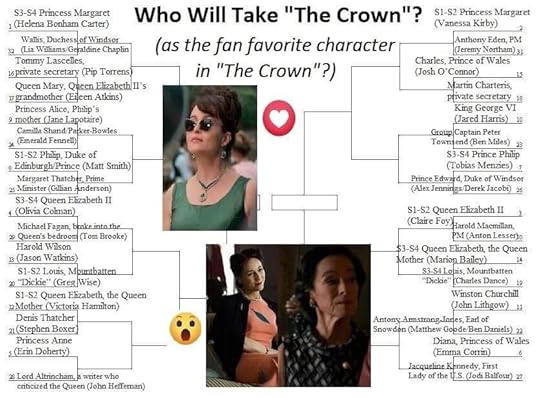
November 28, 2020
Vote for your Favorite Characters from The Crown this December!
In addition to my blog posts, I've decided to continue The Crown love over on my Facebook page with a voting bracket to determine my friends and fans' favorite characters! This form of bracket is limited to 32 characters, so alas, I cannot include every character that's ever appeared on the show. Here's my tentative list so far. I'll have to figure out seeding, but I think it's likely that I'll put characters that were cast anew for S3-4 against each other in the first round. I do have a few characters on here combining the two actors into one, as the characters are important, but the actors' characterizations weren't different enough to really justify them having separate slots.
Here's my tentative list of bracket characters so far.
1. S1-S2 Queen Elizabeth II (Claire Foy)
2. S3-S4 Queen Elizabeth II (Olivia Colman)
3. S1-S2 Philip, Duke of Edinburgh (Matt Smith)
4. S3-S4 Prince Philip (Tobias Menzies)
5. S1-S2 Princess Margaret (Vanessa Kirby)
6. S3-S4 Princess Margaret (Helena Bonham Carter)
7. S1-S2 Queen Elizabeth, the Queen Mother (Victoria Hamilton)
8. S3-S4 Queen Elizabeth, the Queen Mother (Marion Bailey)
9. Group Captain Peter Townsend (Ben Miles)
10. S1-S2 Louis, Earl Mountbatten of Burma “Dickie” (Greg Wise)
11. S3-S4 Louis, Earl Mountbatten of Burma “Dickie” (Charles Dance)
12. Prince Edward, Duke of Windsor (Alex Jennings/Derek Jacobi)
13. Wallis, Duchess of Windsor (Lia Williams/Geraldine Chaplin)
14. Winston Churchill (John Lithgow)
15. Anthony Eden (Jeremy Northam)
16. Harold Macmillan (Anton Lesser)
17. Antony Armstrong-Jones, Earl of Snowdon (Matthew Goode/Ben Daniels)
18. Harold Wilson (Jason Watkins)
19. Princess Anne (Erin Doherty)
20. Charles, Prince of Wales (Josh O’Connor)
21. Diana, Princess of Wales (Emma Corrin)
22. Camilla Shand, later Parker-Bowles (Emerald Fennell)
23. Margaret Thatcher (Gillian Anderson)
I’m also hosting a poll to determine the wild-card contenders for the last 8 slots! You can go vote for your favorite 3 characters from that list until 7:30 PM EST Monday over here.
The voting options are:
Queen Mary, Queen Elizabeth II’s grandmother (Eileen Atkins)
King George VI, Queen Elizabeth II’s father (Jared Harris)
Edward Heath, prime minister from 1970-1974 (Michael Maloney)
Tommy Lascelles, private secretary to both King George VI and Queen Elizabeth II (Pip Torrens)
Michael Adeane, private secretary to Queen Elizabeth II (Will Keen/David Rintoul)
Martin Charteris, private secretary to Queen Elizabeth II (Harry Hadden-Paton/Charles Edwards)
Graham Sutherland (Stephen Dillane) a noted artist who paints a portrait of the ageing Churchill Lord Altrincham (John Heffernan) a writer who penned a scathing criticism of the Queen
Patricia Campbell (Gemma Whelan) a secretary who works with Lord Altrincham and types up his editorial
Billy Graham (Paul Sparks) a prominent American preacher whom Elizabeth consults
John F. Kennedy (Michael C. Hall), the 35th President of the United States who visits the Queen
Jacqueline Kennedy (Jodi Balfour), the First Lady of the United States
Dr Kurt Hahn (Burghart Klaußner) the founder of Gordonstoun, where Philip and Charles went to school
school-aged Prince Philip (Finn Elliot)
school-aged Prince Charles (Julian Baring)
Lyndon B. Johnson, 36th President of the United States (Clancy Brown)
Edward Millward, Prince Charles's Welsh language tutor (Mark Lewis Jones)
Princess Alice, Philip’s mother (Jane Lapotaire)
Robin Woods, Dean of Windsor from 1962 to 1970 (Tim McMullan)
Roddy Llewellyn, Princess Margaret's boyfriend (Harry Treadaway)
Denis Thatcher, Margaret Thatcher’s husband (Stephen Boxer)
Michael Fagan, a man who enters the Queen's bedroom in 1982 (Tom Brooke)
Bob Hawke, 23rd Prime Minister of Australia (Richard Roxburgh)
Derek 'Dazzle' Jennings, a civil servant and friend of Princess Margaret (Tom Burke)
Michael Shea, the Queen's Press Secretary from 1978 to 1987 (Nicholas Farrell)
Prince Edward (Angus Imrie)
Prince Andrew (Tom Byrne)
November 18, 2020
Over-Analyzing The Crown: S4E2 The Balmoral Test
All My Posts on The Crown
S3: 1 & 2: “Olding” & “Margaretology” 3: “Aberfan” 4: “Bubbikins, 5: “Coup” 6: “Tywysog Cymru” 7: “Moondust" 8: “Dangling Man” 9: “Imbroglio” 10: “Cri de Coeur”
S4: 1: “Gold Stick” 2: “The Balmoral Test” 3: “Fairytale” 4: “Favourites” 5: “Fagan” 6: “Terra Nullius”
The Medals, Sashes, and Tiaras of The Crown
Want to vote for The Crown Fan Favorite Contest? It’s all happening over on my Facebook page!
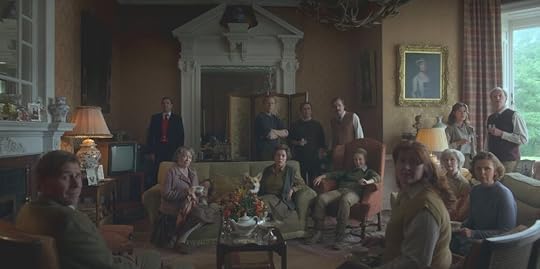
Since I had great fun over-analyzing every episode of Season 3 of The Crown last year, I’m doing the same thing this year! I’ll be /trying/ to write these posts up one episode at a time (although I may watch ahead a bit of my writing), so there won’t be spoilers for any main plot points of any episode except that which I’m covering in the post, although I may point out a little foreshadowing to later strife and such. So if you haven’t watched Season 4 Episode 2 of the Crown yet and don’t want to be spoiled, please stop reading now. :)
This may be my favorite episode of The Crown literally ever, I laughed so hard at all the Thatcher/Royal Family shenanigans and loved the more extended introduction to Diana.
I kind of love episodes that start off with tiny characters we’ve never seen before and will never seen again. Here, it’s a short hunting scene with one of their Balmoral neighbors and his client. I love the way the neighbor says “That’s the line where our estate ends and the other begins. And we never cross that line.”)
Queen talks about how she has so many commitments for the day, but Philip just responds, "I've cancelled them.” The entire scene at the breakfast table where Philip and Anne argue over who ‘s going to get the stag is super funny. This family is so hilariously hunting crazy. Philip and Anne specifically joke about how the great stag head currently in their dining room NEEDS to have a rival to it. glowering at it across the room. Sure enough, at the end of the episode, the stag head is placed exactly where they said it should go.
Royal family members who notably do NOT hunt the stag in this episode: Princess Margaret, who goes out to meet the family for lunch but doesn’t go out with them earlier (In real life, Margaret apparently was NOT a fan of outdoor sports. However - note that later in the episode, she calls Thatcher’s suggestion that the stag was seen on the west shore of the loch “ridiculous,” as the land is low ground and too open, showing that she may not hunt herself, but she absolutely knows what it’s all about), and Prince Charles. Charles actually was and is still quite an enthusiastic hunter, but he is known these days as being quite interested in environmental issues and has spoken out several times about the need to reduce meat consumption. It’s an interesting contradiction. In the episode, I think it’s just to help Diana stand out and further set Charles apart from his family, in a way that hearkens back to the way he felt like an outsider in Season 3’s Imbroglio, at the funeral of his uncle.
Costume notes: Anne is in a navy shirt with a tan plaid vest and skirt that are similar, but not exactly like things she’s worn in real life. The Queen sports a plaid skirt and a matching shirt and sweater set, which conforms very much to her usual, plaid-eriffic, slightly more casual look at Balmoral. The entire family actually tends to wear a lot of plaid when they’re at balmoral. The queen mother is in a light shirt and sweater set, which matches with her generally pastel colored dress wardrobe at this time.
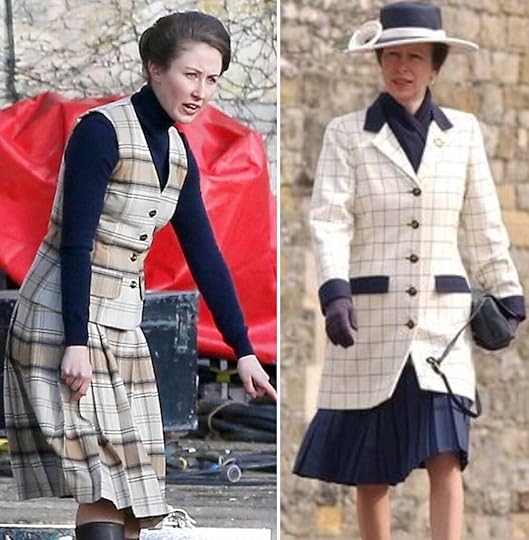
Erin Doherty as Princess Anne in the Crown; Princess Anne in real life.
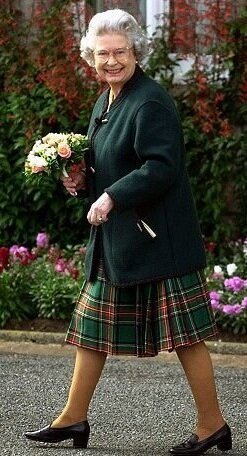
The Queen
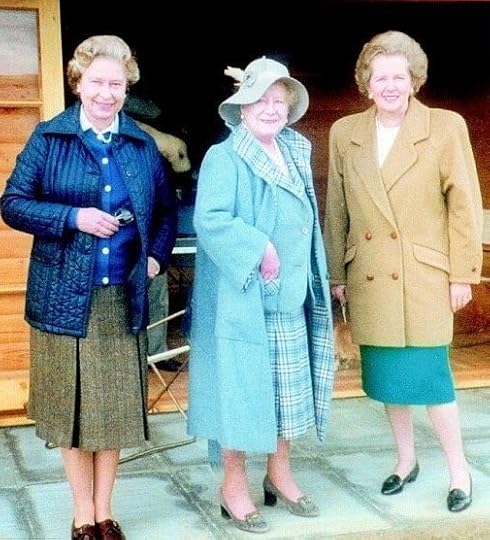
The Queen, Queen Mother, and Margaret Thatcher
I maintain again that it looks like they put Olivia Colman in a bit of padding to play this queen this season, which is an odd choice, because the queen did not look like that in 1980. I checked, Colman wasn’t pregnant during the shooting for The Crown, and she doesn’t look like this in real life (see, pictures from her instagram), and the queen herself stayed pretty damn trim throughout the 1980s. I’m not going to post pics of the queen in the 1980s next to the Queen in the Crown in the 1980s next to each other because that just feels like i’m buying into the fact that we should give a shit about anyone’s waist size, but it’s just…such a weird choice?
According to Diana: Her True Story in her Own Words, Diana’s grandmother Lady Fermoy really did chaperone an opera date with Prince Charles to a Verdi opera - Requiem in real life, although here, the music played is from La Traviata. In real life, they also had supper at the palace afterward with Lady Fermoy. Interestingly enough, she’s shown later in the episode pressuring Diana into being a suitable mate for Charles and emphasizing how important the weekend in Balmoral is, but in real life, her grandmother warned Diana that the royal family had an unusual sense of humor and they might not get along very well. Diana ignored her at the time.
They only play a short snippet of the opera they play, but according to the internet, the specific song snippet is from E strano! E strano! The translation of the lyrics is uh, extremely on point for the themes in this episode, as by the end, Charles decides to marry a woman he doesn’t love and give up the woman he does (although of course, that woman is already married to someone else, so like, maybe should have made that decision years before, yeah, Charlie boy?).
How strange it is … how strange!
Those words are carved upon my heart!
Would a true love bring me misfortune?
What do you think, o my troubled spirit?
No man before kindled a flame like this.
Oh, joy …I never knew …
To love and to be loved!
Can I disdain this for a life of sterile pleasure?
I do love that they put Diana in a green/blue dress on a date at an opera by Verdi. I couldn’t find any exact matches to this dress, but she did wear a lot of green and turquoise dresses in the 80s. Apparently while she was dating Charles, she actually borrowed a lot of clothes from her friends, as she had a pretty small wardrobe herself and needed more to wear.
Her conversation with Charles indicates their differences in viewpoint and age so intently: Diana says she loves Verdi because he’s so romantic. Charles said “to focus simply on romance diminishes Verdi’s legacy and musical influence. His music played such a key role in the Italian unification, too.” They see things very differently, and he lectures her like her teacher, not like her boyfriend.
Charles tells her he’ll be out of the country and in scotland for a while and won’t see her until the autumn, quite matter of factly; she says the time will drag by, indicating how much more interested she is in him than he is in her.
Emma Corrin just embodies Diana so well. I think it's the way she holds her head and neck and shoulders?
Was that curtsey to him like a sexy curtsey? It was sexy! But he didn’t kiss her and only shook her hand and CLEARLY DOES NOT DESERVE HER SEXY CURTSEY. Poor Diana.
”Was that very frigid?”
“Yes. but perfectly gentlemanly.”
“Princely.”
“Sorry. princely.”
This exchange indicates their gap in status. Diana actually did not refer to Charles by first name until after they were married; she called him “Sir” up until then.
Apparently Charles wasn’t QUITE as standoffish and prudish with Diana in real life as he is shown to be in The Crown. As I mentioned in the previous blog post, Diana stated that when they met for the first time since he’d broken up with her sister at a friend’s house party, he began kissing her after she sympathized with him over Lord Mountbatten’s death.
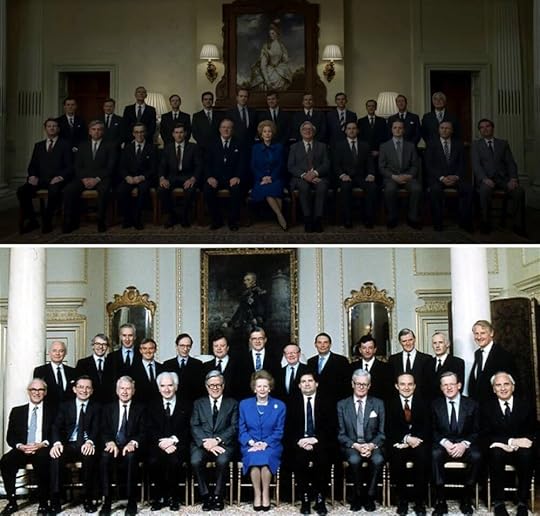
The top photo was actually from the final cabinet picture in this episode, not the first. In the first posed pic, she’s wearing a feminine floral, but by the end, she’s moved into her power color of blue.
The bottom photo is the real Margaret Thatcher with her cabinet. Notice how the portrait behind them in the TV series is a woman, not a man, and is less ornate than the real life picture.

The real life Margaret Thatcher and the Queen at Balmoral, vs. Gillian Anderson as Margaret Thatcher in The Crown.
I will admit that I know almost nothing about Margaret Thatcher and her policies, so I can’t speak to the historical accuracy of any of her scenes with her cabinet. I’ll do some research and come back to this. : )
The first cabinet photo scene is so striking - Margaret Thatcher stands out in her floral dress so intensely from all the men in suits around her, in like an authoritative but also feminine way.
As shown in the cabinet photos at the beginning and end of this episode, Margaret Thatcher really was the only woman in her cabinet for most of her time as prime minister though; she only appointed one female minister, Janet Young, who served as the Chancellor of the Duchy of Lancaster (which is a weird role, as it doesn’t actually have much to do with the running of the duchy and more allows the PM to appoint an additional minister to the cabinet), Leader of the House of Lords, and the Lord Privy Seal from 1981-1983.
Thatcher bemoans how unimaginative and fearful some of her cabinet ministers are as she flies with her husband to Balmoral, referring to their “faint hearts.”
"Balmoral tests" refers to the royal family’s habit of subjecting their guests to secret tests. This apparently IS a thing that happens. I don’t know if the royal family INTENDS to put their guests through the wringer, but they do seem to have very specific traditions that they expect people to adhere to without necessarily bothering to tell them about it.
The Thatchers are bemused by having separate rooms at Balmoral and confused about how to tip the maids as well.
Margaret Thatcher’s strange contradictions of being the most powerful person in the country but also wanting to be super feminine and keep to traditional gender roles continues in this episode. When a maid starts to unpack her husband’s suitcase, she stops her, saying, "I like to do that myself, especially for my husband."
Maid: “I can't help but notice, ma'am, but you didn't bring any outdoor shoes."
Margaret: “No.”
Denis: "What a strange thing to say."
HAH. This apparently was a thing that actually consistently happened every time Margaret Thatcher visited Balmoral - she never once had the correct shoes for outdoor events.
Fun fact, immediately after this scene, we transition to a close up shot on Queen’s shoes in the next scene, which are very outdoor and appropriate and brown.
Margaret Thatcher: "Are we allowed to sleep in one bed?"
Denis Thatcher: "I will check the protocol sheet."
I don’t know about the Thatchers, but the Queen and Prince Philip definitely have separate bedrooms. This is pretty common in the British upper class actually, even now.
THE ROYAL FAMILY IS ALL SO brown so rustic and dirty and talking about stags in heat and omg. AND THEN MARGARET THATCHER AND THER HUSBAND WALK IN IN TUXEDO AND LONG EVENING DRESS. Thatcher’s dress in the series is pretty similar to some of her real life outfits.
They really are so rude to her, it’s hilarious but honestly, i feel terrible for her. If there was a protocol sheet laid out in the room, it SHOULD have included details about the schedule and dress code for every event, not just leaving them to assume that because dinner was black tie, the drinks before dinner must be black tie.
Philip: “But it’s TEA TIME.” Is it? It’s 6 pm. What? Everything I’ve read online says that tea time generally is 3:30-5 pm, but I’m not the British royal family so uhh, what do I know?
Corgi appearance: on the queen’s lap and also trying to get food off the plates.
Philip-ism: “Christ, do you think they’ll come to lunch tomorrow in their pajamas?”

Top: the cast of the Crown. Bottom: The queen stalking about at Balmoral.
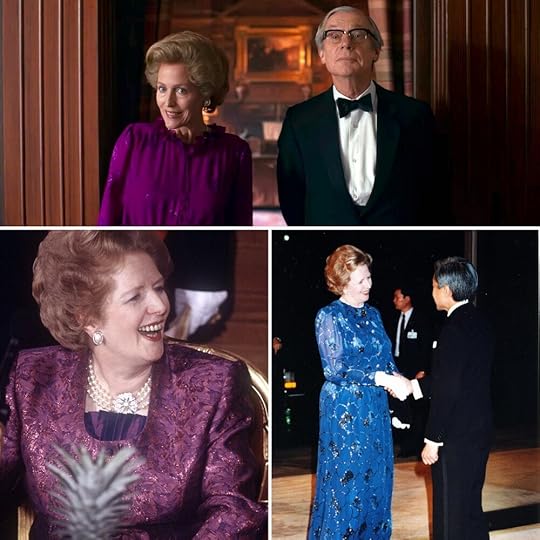
Top, Gillian Anderson and Stephen Boxer playing Margaret and Denis Thatcher in The Crown. Bottom, the real life Margaret Thatcher.
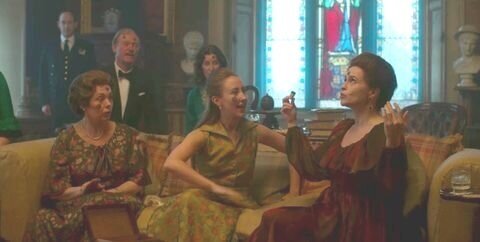
A screenshot from the hilarious Ibble Dibble scene.
Princess Anne and then her husband doing stag bellows at the dinner table while everyone's wearing super formal evening wear, I’m dying.
Queen Mother talking about conservation of stags while Mr. Thatcher tries to tout it as a business proposition. The Royal Family really does have a strange relationship with animals, where hunting is a regular activity and tradition, but several members of the family tout conservation and environmentalism. In real life, the queen mother and Denis Thatcher apparently got on quite well and apparently had similar tastes in drinks.
Ibble Dibble looks like just the most fun game ever. The Independent has the rules online now if you want to play! They clearly are trying to pull Margaret Thatcher into their circle, and she just refuses to let down her guard and risk getting a cork mark on her face, as she says the silly rhyme in the slowest manner possible, somewhat ruining the whole vibe.
The queen once again demonstrates how much more empathetic she is and how much more understanding of the weirdness of being around the royal family than Philip is, who has no patience for that.
Philip: “What was she doing”
Queen: “Yes, she was rather hopeless. but i’m willing to give her the benefit of the doubt. It was probably just nerves.”
P “Of what?”
Q “Of the situation in which she finds herself. “
P “We were playing parlor games, having fun.”
Q “Perhaps her idea of fun is something else entirely.”
P “or she’s incapable of it and wouldn’t know fun of it bit her on the backside.”
Husband John and I have decided that we will now say “tippity toppity down with the nazis" every time we drink, just like the Queen Mother right before she drank her whiskey during the drinking game.
Margaret Thatcher refers to the parlor games as a waste of a whole evening, and pulls out documents to work on in bed. Her husband complains and suggests he sleep in the other room assigned to them. Margaret says, “Don’t you dare! We don’t want to catch any upper-class habits. Those that sleep apart grow apart.” She points out a book on the bedside table for him to read. He notes that it’s “Hunting Memoirs of Balmoral Castle” and starts reading a letter from Prince Albert (Queen Victoria’s husband) from September 5, 1848 in a German accent, which is hilarious.
OH MY GOD MARGARET THATCHER'S DELAYED ENTRANCE OUT STALKING - so you finally see what she's wearing and it's like a full bright blue business suit with heels.
The Queen strikes up a conversation with the prime minister but noting that her father taught her how to stalk. Margaret reminisced about how she connected with her father by working with him and listening to him practice his alderman speeches. You can tell the queen is really trying to connect with her (“how lovely for you both”) and just like….not…getting there.
Queen: “When stalking, the trick really, is to disappear into nature, to preserve the element of surprise. So next time, you might not wear bright blue. It means the stag can see you. Or wear scent. It means he can smell you.” /Thatcher almost falls/ “And now he can hear you too.” Thatcher then offers to go back and change. I just adore the Queen’s passive aggressive away of getting her point across, lol.
Margaret Thatcher really did use the term “wet” and associated upper class folks with being "wet, weak, and chinless.” She thought they weren’t brave enough to really do what needed to be done to fix the country.
In her usual straightforward way, Princess Margaret calls out thatcher, for 1., calling Elizabeth her sister instead of the queen, 2., sitting in Queen Victoria’s chair, which no one sits in, and 3. working on a bank holiday.
The “don’t sit in queen Victoria’s chair” thing is real, according to “Diana: Her true story in her own words.”
Battle of the Margarets:
Prime Minister Margaret: ”It is hard to have a holiday when the country is in its current state.”
Princess Margaret: "The country has been a state before, it will doubtless be in a state again. One learns, when one has the benefit of experience, that sometimes time off is the most sensible course of action.”
Prime Minister Margaret: “Time off gives me no pleasure.”
Princess Margaret: “It might give you something more important than that. Perspective."
Charles arrives at Balmoral and promptly calls Camilla to whine about her having a husband and children of her own and not being able to drop everything and come with him to Balmoral. Camilla tells Charles that he needs a young women who's free to follow him around and is willing to give up her life for him, straight up encouraging him to continue seeing Diana.
In real life, both Camilla and her husband Andrew were at Balmoral when Diana visited for the first time and met the family.
The hopelessness of their relationship is illustrated when Camilla suggests Diana as a possible wife for Charles. Charles: “Don’t say that. i’d much rather hear how jealous you are.”
Camilla: “I would be, but it’s hopeless, isn’t it?”
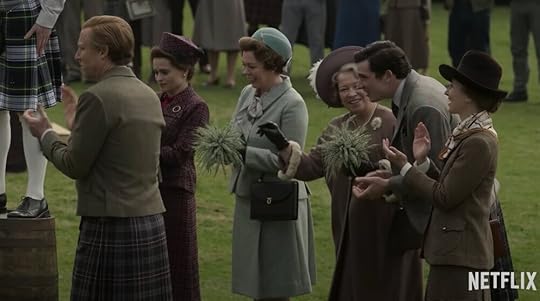
The royal family at a Scottish festival in The Crown.
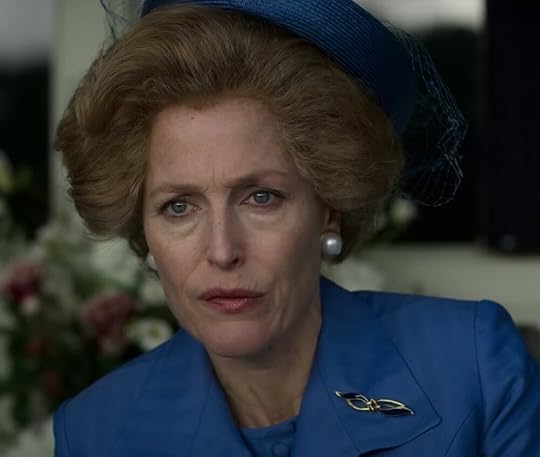
Gillian Anderson as Margaret Thatcher, having anti-royalist, anti-haggis, and anti-Ibble Dibble thoughts.
The royals attend a super fun looking Scottish festival that Margaret Thatcher does not even slightly appreciate, as she’s in a terrible mood after seeing several of her cabinet members criticize her publicly on the news. While there, watching a haggis throwing contest, she wonders why she’s in “a half-Germanic half-Scottish cuckoo-land,” as her husband calls it, and calls the royals boring, snobbish and rude, comparing them to her upper-class critics in her cabinet. She then says the country needs a change from top to bottom and makes an excuse to leave Balmoral early.
In real life, although Margaret Thatcher didn’t like the upper class very much, she seemed to get along rather well with the Queen and never even once suggested the abolition of the monarchy, despite the ominous undertones of this scene.
I really enjoy the royals’ conversation reaction to this.
Princess Margaret: "Life in post war-Britain is one uninterrupted crisis. and yet none of the other prime ministers left early." …..
Queen: "Perhaps we weren't very friendly."
Princess Margaret: "What are you talking about? I was incredibly friendly. I positively gushed." (Margaret has the best passive aggressive lines.)
The juxtaposition of the Thatcher’s failure of a Balmoral visit vs. Diana’s success there is emphasized by the fact that Diana literally drives up as Thatcher leaves. I enjoy that the queen doesn’t even know who she is at first.
The maid, still fresh from dealing with Margaret Thatcher, asks Diana if she brought outdoor shoes. Diana responds that she ONLY brought outdoor shoes.
Queen, about Charles and Diana: "i can't keep up, is this one a friend friend or a girl friend"
In real life, on her weekend trip at Balmoral, Diana stayed at a grace and favour cottage on the estate with her sister Jane, who was married to Robert Fellowes, an assistant private secretary to the queen. It seems that she IS staying in a separate cottage on the estate, but her sister and husband aren’t mentioned and it’s not really commented upon; i missed that she wasn’t staying in the castle proper on the first watch actually. As I mentioned earlier, Camilla and Andrew Parker Bowles were also at Balmoral that weekend in real life.
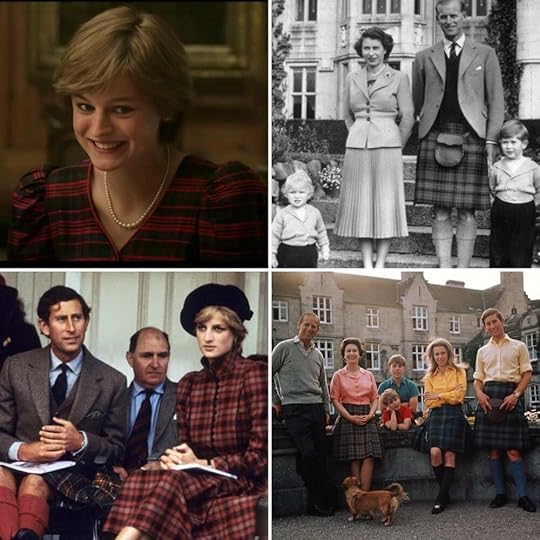
Top left: Emma Corrin in the Crown, bottom left: Princess Diana and Prince Charles in real life. Top Right: The Queen and the Duke of Edinburgh with tiny Prince Charles and Princess Anne at Balmoral. Bottom Right: The whole royal fam in plaid.

Top: Emma Corrin and Tobias Menzies in The Crown. Bottom: Princess Diana and Prince Charles at Balmoral.
She debuts well at the dinner in a lovely plaid dress that looks very much like a few outfits she wore in real life. She also blends in very well with the family, who wears a LOT of plaid when they’re at Balmoral. She also looks like part of the family when she goes off hunting the next morning with Prince Philip, as she’s dressed almost exactly like him.
Diana to Philip: "The muckier the better, I'm a country girl at heart." Philip smiles very broadly at this, seemingly delighted.
In real life, Diana really didn’t like hunting, but she had been around it and knew how to talk about it and deal with it. She knew how to impress people. And she did grow up in the country, so she’s comfortable with that sort of thing.
The whole stag story line feels incredibly familiar, and reminds me very much of another famous stag scene, namely, a significant scene in the 2006 film The Queen. That film, about the aftermath of Diana’s death, shows the queen connecting with a prize stag her husband is hunting and shoos it away. Later, the stag dies, and the queen is terribly affected by it, even shedding a hidden tear over it. People have argued about these scenes a lot, as the Queen has hunted her entire life and would likely not have felt that much emotion over a stag, but it’s very symbolic and meant to show someone beautiful and lovely being captured and destroyed, just like Diana. It has to be a purposeful tribute to that film, as Peter Morgan, the creator and writer of The Crown, ALSO wrote The Queen (and the Audience, a brilliant play about the queen’s meetings with her prime ministers. He’s made a LOT of money off writing about the royal family).
Throughout the episode, there’ve been little moments where we see the stag in various bits of scenery. After they catch him and bring it to the castle, there’s a moment where all those pieces of scenery are revisited, only now they’re empty, no stag to be seen.
Diana leaves Balmoral wearing a distinctive striped sweater that’s almost identical to one Diana wore in real life. The photos we have of Diana in that sweater actually look SO much like Emma Corrin, who plays her in The Crown, that I had to look at them several times to check.
She’s now spent the weekend with his family but Charles still doesn’t touch her as they say goodbye, not even for a hug or a kiss on the cheek. He says, very romantically, “You’ve been a great sport.”
Charles talking to Camilla. They continue to talk in a very negative way about a lot of people, as was shown in Season 3, imitating the way that Wallis Simpson and Edward spoke about the royal family. Charles notes that Diana got "rave reviews from the whole ghastly politburo." “In the history of Balmoral, no one has ever passed the test with such flying colors.” Camilla looks beautifully sad as Charles tells her that his family wants him to marry Diana.
Charles complains to Camilla that Diana’s a child. She was 20 when she married Charles, who was nearly 13 years older than her. There have been reports that Charles actually did refer to Diana as a child in real life, noting that she was “exquisitely pretty, a perfect poppy,” but that “she does not look old enough to be out of school, much less married.”
This entire conversation also foreshadows how often Charles and Camilla are really talking and in how much detail about his life with Diana. The show leaves it a little bit ambiguous as to whether Charles is actually having a physical relationship with Camilla at this point in his life, but there’s definitely a huge emotional attachment.
Philip tells Charles that the family wants him to marry Diana. This scene takes place in the hanging room with the stag all strung up, dead and trapped. The symbolism is a bit on the nose here, yes? But fortunately, Charles points it out in the dialogue, saying that her father was “oblivious to the grotesque symbolism. It might as well have been me strung up and skinned.”
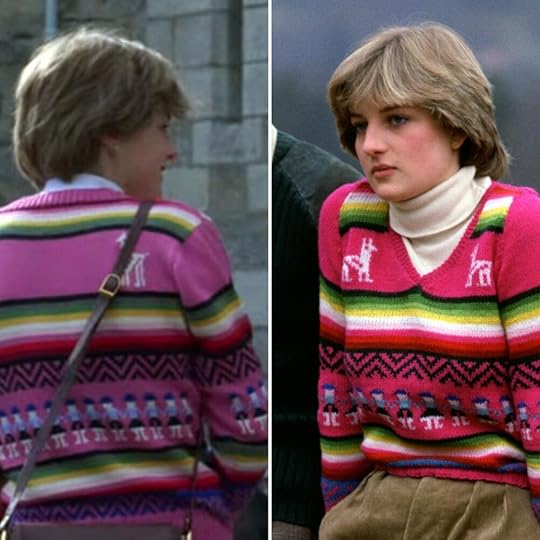
Emma Corrin on the left, real life Diana on the right. (She looks INCREDIBLY like Emma Corrin here, doesn’t she? It’s bizarre).

Real Life Diana on the left, Emma Corrin in the Crown on the right.
Margaret Thatcher puts on a formidable purple suit, pulls out a symbolically shaped sword letter opener, makes a list of the ministers who are making problems for her, and then fires them one after another in a marvelous sequence. I disagree with Thatcherism on probably every single point, but it’s hard not to love some of her scenes in this season; she’s just so determined.
The queen passive aggressively notes at the beginning of her meeting with Thatcher: “I’m always mystified by those who don’t feel at home at Balmoral. Some just don’t. They come and are bewildered by it, by the weather and traditions. They see only cruelty in the blood sports, instead of kindness or necessity. But there have been blood sports here too, I see, you have a brand new cabinet.”
Thatcher specifically says that she fired her ministers because they were from a background that made them privileged, entitled, and lacking grit. The queen mildly questions this choice, noting that Thatcher is playing "A dangerous game, making enemies left right and center.” Thatcher says, "Not if someone is unafraid of having enemies." “Are you?” “Oh yes” - and then Thatcher recites a long quotation, suggesting that perhaps she was prepared for this criticism.
The poem she recites to the queen is by Scottish author Charles McKay: ““You have no enemies, you say? Alas, my friend, the boast is poor. He who has mingled in the fray of duty that the brave endure, must have made foes. If you have none, small is the work that you have done. You’ve hit no traitor on the hip. You’ve dashed no cup from perjured lip. You’ve never turned the wrong to right. You’ve been a coward in the fight.”"
In 1981, Thatcher really did fire three government ministers who were critical of her economic policies and transferred a fourth to Northern Ireland. The dismissed ministers were the deputy foreign minister, the education minister, and majority leader of the House of Lords. Employment Secretary James Prior was transferred to the position of secretary of state for Northern Ireland against his wishes.
She looks so incredibly triumphant
Anne tells Charles to get on with it and marry Diana even though they barely know each other, calling him Eeyore in the process (which is basically a perfect description of his constant hangdog looks this season, although I can’t find any indication that he actually was called that in real life). She spouts out a couple wonderful Anne-isms, saying “After a selection process that involved half of Britain, you’ve somehow stumbled on the perfect one in age, looks, and breeding. Or have you managed to find fault even in perfection?” “Don't fight it. She's perfect. She even got the stag, damn her." and “Those legs. Cow.” These admiringly positive but petty statements would transform in a few episodes to outright jealousy.
Anne is two years younger than Charles and at the time of this episode, has already been married almost 7 years (marrying at age 23) and had two children. Their parents married when Elizabeth was 21 and Philip was 26. So yeah, they all seem to be pretty desperate for the 31 year old Charles to get on with it already.
Charles expresses the concern that he and Diana barely know each other. This is a inner voice he really should have listened to. Diana said in her life that they had only met in person 13 times before he asked her to marry him.
Anne KNOWS that Charles still speaks to Camilla all the time. She says, "Time to close this chapter. Time to put the whole Parker Bowles saga behind us all for good." HAHAHAHAHA.
The show ends with trading visuals of the stag head being brought to Balmoral and mounted, Thatcher posing happily with her new cabinet for a photo, and Diana walking down the street with her head down, surrounded by photographers, which is both a happy and foreboding scene. In real life, before they even got engaged, Diana sometimes had as many as 30 journalists following her around. A news media organization rented the flat opposite hers so they could look in at her bedroom. I’ll get into this more in the next episode, but it’s clear that this season is going to focus a lot on the media sensation around Diana, which was wholly unexpected and unprecedented.
Music note: These scenes take place with the Overture from La Traviata playing in the background, bringing back the opera’s sad themes. La Traviata tells the story of a courtesan dying of tuberculosis who leaves her lifestyle to be with the man she loves, but ultimately leaves him behind at his father’s request in order to avoid ruining his and his family’s reputation. There’s lots of strife, but her lover ultimately comes back to her and forgives her right before she dies. (and uh, yeah, it’s very similar to the plot line of Moulin Rouge). The story doesn’t align with Charles and Diana’s, but the elements of love, duty, and family pressure all strike a chord here.
Over-Analyzing The Crown S4E2: The Balmoral Test

This post is part of a series on Season 4 of The Crown. All my posts on The Crown are available here !
Since I had great fun over-analyzing every episode of Season 3 of The Crown last year, I’m doing the same thing this year! I’ll be /trying/ to write these posts up one episode at a time (although I may watch ahead a bit of my writing), so there won’t be spoilers for any main plot points of any episode except that which I’m covering in the post, although I may point out a little foreshadowing to later strife and such. So if you haven’t watched Season 4 Episode 2 of the Crown yet and don’t want to be spoiled, please stop reading now. :)
This may be my favorite episode of The Crown literally ever, I laughed so hard at all the Thatcher/Royal Family shenanigans and loved the more extended introduction to Diana.
I kind of love episodes that start off with tiny characters we’ve never seen before and will never seen again. Here, it’s a short hunting scene with one of their Balmoral neighbors and his client. I love the way the neighbor says “That’s the line where our estate ends and the other begins. And we never cross that line.”)
Queen talks about how she has so many commitments for the day, but Philip just responds, "I've cancelled them.” The entire scene at the breakfast table where Philip and Anne argue over who ‘s going to get the stag is super funny. This family is so hilariously hunting crazy. Philip and Anne specifically joke about how the great stag head currently in their dining room NEEDS to have a rival to it. glowering at it across the room. Sure enough, at the end of the episode, the stag head is placed exactly where they said it should go.
Royal family members who notably do NOT hunt the stag in this episode: Princess Margaret, who goes out to meet the family for lunch but doesn’t go out with them earlier (In real life, Margaret apparently was NOT a fan of outdoor sports. However - note that later in the episode, she calls Thatcher’s suggestion that the stag was seen on the west shore of the loch “ridiculous,” as the land is low ground and too open, showing that she may not hunt herself, but she absolutely knows what it’s all about), and Prince Charles. Charles actually was and is still quite an enthusiastic hunter, but he is known these days as being quite interested in environmental issues and has spoken out several times about the need to reduce meat consumption. It’s an interesting contradiction. In the episode, I think it’s just to help Diana stand out and further set Charles apart from his family, in a way that hearkens back to the way he felt like an outsider in Season 3’s Imbroglio, at the funeral of his uncle.
Costume notes: Anne is in a navy shirt with a tan plaid vest and skirt that are similar, but not exactly like things she’s worn in real life. The Queen sports a plaid skirt and a matching shirt and sweater set, which conforms very much to her usual, plaid-eriffic, slightly more casual look at Balmoral. The entire family actually tends to wear a lot of plaid when they’re at balmoral. The queen mother is in a light shirt and sweater set, which matches with her generally pastel colored dress wardrobe at this time.

Erin Doherty as Princess Anne in the Crown; Princess Anne in real life.

The Queen

The Queen, Queen Mother, and Margaret Thatcher
I maintain again that it looks like they put Olivia Colman in a bit of padding to play this queen this season, which is an odd choice, because the queen did not look like that in 1980. I checked, Colman wasn’t pregnant during the shooting for The Crown, and she doesn’t look like this in real life (see, pictures from her instagram), and the queen herself stayed pretty damn trim throughout the 1980s. I’m not going to post pics of the queen in the 1980s next to the Queen in the Crown in the 1980s next to each other because that just feels like i’m buying into the fact that we should give a shit about anyone’s waist size, but it’s just…such a weird choice?
According to Diana: Her True Story in her Own Words, Diana’s grandmother Lady Fermoy really did chaperone an opera date with Prince Charles to a Verdi opera - Requiem in real life, although here, the music played is from La Traviata. In real life, they also had supper at the palace afterward with Lady Fermoy. Interestingly enough, she’s shown later in the episode pressuring Diana into being a suitable mate for Charles and emphasizing how important the weekend in Balmoral is, but in real life, her grandmother warned Diana that the royal family had an unusual sense of humor and they might not get along very well. Diana ignored her at the time.
They only play a short snippet of the opera they play, but according to the internet, the specific song snippet is from E strano! E strano! The translation of the lyrics is uh, extremely on point for the themes in this episode, as by the end, Charles decides to marry a woman he doesn’t love and give up the woman he does (although of course, that woman is already married to someone else, so like, maybe should have made that decision years before, yeah, Charlie boy?).
How strange it is … how strange!
Those words are carved upon my heart!
Would a true love bring me misfortune?
What do you think, o my troubled spirit?
No man before kindled a flame like this.
Oh, joy …I never knew …
To love and to be loved!
Can I disdain this for a life of sterile pleasure?
I do love that they put Diana in a green/blue dress on a date at an opera by Verdi. I couldn’t find any exact matches to this dress, but she did wear a lot of green and turquoise dresses in the 80s. Apparently while she was dating Charles, she actually borrowed a lot of clothes from her friends, as she had a pretty small wardrobe herself and needed more to wear.
Her conversation with Charles indicates their differences in viewpoint and age so intently: Diana says she loves Verdi because he’s so romantic. Charles said “to focus simply on romance diminishes Verdi’s legacy and musical influence. His music played such a key role in the Italian unification, too.” They see things very differently, and he lectures her like her teacher, not like her boyfriend.
Charles tells her he’ll be out of the country and in scotland for a while and won’t see her until the autumn, quite matter of factly; she says the time will drag by, indicating how much more interested she is in him than he is in her.
Emma Corrin just embodies Diana so well. I think it's the way she holds her head and neck and shoulders?
Was that curtsey to him like a sexy curtsey? It was sexy! But he didn’t kiss her and only shook her hand and CLEARLY DOES NOT DESERVE HER SEXY CURTSEY. Poor Diana.
”Was that very frigid?”
“Yes. but perfectly gentlemanly.”
“Princely.”
“Sorry. princely.”
This exchange indicates their gap in status. Diana actually did not refer to Charles by first name until after they were married; she called him “Sir” up until then.
Apparently Charles wasn’t QUITE as standoffish and prudish with Diana in real life as he is shown to be in The Crown. As I mentioned in the previous blog post, Diana stated that when they met for the first time since he’d broken up with her sister at a friend’s house party, he began kissing her after she sympathized with him over Lord Mountbatten’s death.

The top photo was actually from the final cabinet picture in this episode, not the first. In the first posed pic, she’s wearing a feminine floral, but by the end, she’s moved into her power color of blue.
The bottom photo is the real Margaret Thatcher with her cabinet. Notice how the portrait behind them in the TV series is a woman, not a man, and is less ornate than the real life picture.

The real life Margaret Thatcher and the Queen at Balmoral, vs. Gillian Anderson as Margaret Thatcher in The Crown.
I will admit that I know almost nothing about Margaret Thatcher and her policies, so I can’t speak to the historical accuracy of any of her scenes with her cabinet. I’ll do some research and come back to this. : )
The first cabinet photo scene is so striking - Margaret Thatcher stands out in her floral dress so intensely from all the men in suits around her, in like an authoritative but also feminine way.
As shown in the cabinet photos at the beginning and end of this episode, Margaret Thatcher really was the only woman in her cabinet for most of her time as prime minister though; she only appointed one female minister, Janet Young, who served as the Chancellor of the Duchy of Lancaster (which is a weird role, as it doesn’t actually have much to do with the running of the duchy and more allows the PM to appoint an additional minister to the cabinet), Leader of the House of Lords, and the Lord Privy Seal from 1981-1983.
Thatcher bemoans how unimaginative and fearful some of her cabinet ministers are as she flies with her husband to Balmoral, referring to their “faint hearts.”
"Balmoral tests" refers to the royal family’s habit of subjecting their guests to secret tests. This apparently IS a thing that happens. I don’t know if the royal family INTENDS to put their guests through the wringer, but they do seem to have very specific traditions that they expect people to adhere to without necessarily bothering to tell them about it.
The Thatchers are bemused by having separate rooms at Balmoral and confused about how to tip the maids as well.
Margaret Thatcher’s strange contradictions of being the most powerful person in the country but also wanting to be super feminine and keep to traditional gender roles continues in this episode. When a maid starts to unpack her husband’s suitcase, she stops her, saying, "I like to do that myself, especially for my husband."
Maid: “I can't help but notice, ma'am, but you didn't bring any outdoor shoes."
Margaret: “No.”
Denis: "What a strange thing to say."
HAH. This apparently was a thing that actually consistently happened every time Margaret Thatcher visited Balmoral - she never once had the correct shoes for outdoor events.
Fun fact, immediately after this scene, we transition to a close up shot on Queen’s shoes in the next scene, which are very outdoor and appropriate and brown.
Margaret Thatcher: "Are we allowed to sleep in one bed?"
Denis Thatcher: "I will check the protocol sheet."
I don’t know about the Thatchers, but the Queen and Prince Philip definitely have separate bedrooms. This is pretty common in the British upper class actually, even now.
THE ROYAL FAMILY IS ALL SO brown so rustic and dirty and talking about stags in heat and omg. AND THEN MARGARET THATCHER AND THER HUSBAND WALK IN IN TUXEDO AND LONG EVENING DRESS. Thatcher’s dress in the series is pretty similar to some of her real life outfits.
They really are so rude to her, it’s hilarious but honestly, i feel terrible for her. If there was a protocol sheet laid out in the room, it SHOULD have included details about the schedule and dress code for every event, not just leaving them to assume that because dinner was black tie, the drinks before dinner must be black tie.
Philip: “But it’s TEA TIME.” Is it? It’s 6 pm. What? Everything I’ve read online says that tea time generally is 3:30-5 pm, but I’m not the British royal family so uhh, what do I know?
Corgi appearance: on the queen’s lap and also trying to get food off the plates.
Philip-ism: “Christ, do you think they’ll come to lunch tomorrow in their pajamas?”

Top: the cast of the Crown. Bottom: The queen stalking about at Balmoral.

Top, Gillian Anderson and Stephen Boxer playing Margaret and Denis Thatcher in The Crown. Bottom, the real life Margaret Thatcher.

A screenshot from the hilarious Ibble Dibble scene.
Princess Anne and then her husband doing stag bellows at the dinner table while everyone's wearing super formal evening wear, I’m dying.
Queen Mother talking about conservation of stags while Mr. Thatcher tries to tout it as a business proposition. The Royal Family really does have a strange relationship with animals, where hunting is a regular activity and tradition, but several members of the family tout conservation and environmentalism. In real life, the queen mother and Denis Thatcher apparently got on quite well and apparently had similar tastes in drinks.
Ibble Dibble looks like just the most fun game ever. The Independent has the rules online now if you want to play! They clearly are trying to pull Margaret Thatcher into their circle, and she just refuses to let down her guard and risk getting a cork mark on her face, as she says the silly rhyme in the slowest manner possible, somewhat ruining the whole vibe.
The queen once again demonstrates how much more empathetic she is and how much more understanding of the weirdness of being around the royal family than Philip is, who has no patience for that.
Philip: “What was she doing”
Queen: “Yes, she was rather hopeless. but i’m willing to give her the benefit of the doubt. It was probably just nerves.”
P “Of what?”
Q “Of the situation in which she finds herself. “
P “We were playing parlor games, having fun.”
Q “Perhaps her idea of fun is something else entirely.”
P “or she’s incapable of it and wouldn’t know fun of it bit her on the backside.”
Husband John and I have decided that we will now say “tippity toppity down with the nazis" every time we drink, just like the Queen Mother right before she drank her whiskey during the drinking game.
Margaret Thatcher refers to the parlor games as a waste of a whole evening, and pulls out documents to work on in bed. Her husband complains and suggests he sleep in the other room assigned to them. Margaret says, “Don’t you dare! We don’t want to catch any upper-class habits. Those that sleep apart grow apart.” She points out a book on the bedside table for him to read. He notes that it’s “Hunting Memoirs of Balmoral Castle” and starts reading a letter from Prince Albert (Queen Victoria’s husband) from September 5, 1848 in a German accent, which is hilarious.
OH MY GOD MARGARET THATCHER'S DELAYED ENTRANCE OUT STALKING - so you finally see what she's wearing and it's like a full bright blue business suit with heels.
The Queen strikes up a conversation with the prime minister but noting that her father taught her how to stalk. Margaret reminisced about how she connected with her father by working with him and listening to him practice his alderman speeches. You can tell the queen is really trying to connect with her (“how lovely for you both”) and just like….not…getting there.
Queen: “When stalking, the trick really, is to disappear into nature, to preserve the element of surprise. So next time, you might not wear bright blue. It means the stag can see you. Or wear scent. It means he can smell you.” /Thatcher almost falls/ “And now he can hear you too.” Thatcher then offers to go back and change. I just adore the Queen’s passive aggressive away of getting her point across, lol.
Margaret Thatcher really did use the term “wet” and associated upper class folks with being "wet, weak, and chinless.” She thought they weren’t brave enough to really do what needed to be done to fix the country.
In her usual straightforward way, Princess Margaret calls out thatcher, for 1., calling Elizabeth her sister instead of the queen, 2., sitting in Queen Victoria’s chair, which no one sits in, and 3. working on a bank holiday.
The “don’t sit in queen Victoria’s chair” thing is real, according to “Diana: Her true story in her own words.”
Battle of the Margarets:
Prime Minister Margaret: ”It is hard to have a holiday when the country is in its current state.”
Princess Margaret: "The country has been a state before, it will doubtless be in a state again. One learns, when one has the benefit of experience, that sometimes time off is the most sensible course of action.”
Prime Minister Margaret: “Time off gives me no pleasure.”
Princess Margaret: “It might give you something more important than that. Perspective."
Charles arrives at Balmoral and promptly calls Camilla to whine about her having a husband and children of her own and not being able to drop everything and come with him to Balmoral. Camilla tells Charles that he needs a young women who's free follow him around and is willing to give up her life for you, straight up encouraging him to continue seeing Diana.
In real life, both Camilla and her husband Andrew were at Balmoral when Diana visited for the first time and met the family.
The hopelessness of their relationship is illustrated when Camilla suggests Diana as a possible wife for Charles. Charles: “Don’t say that. i’d much rather hear how jealous you are.”
Camilla: “I would be, but it’s hopeless, isn’t it?”

The royal family at a Scottish festival in The Crown.

Gillian Anderson as Margaret Thatcher, having anti-royalist, anti-haggis, and anti-Ibble Dibble thoughts.
The royals attend a super fun looking Scottish festival that Margaret Thatcher does not even slightly appreciate, as she’s in a terrible mood after seeing several of her cabinet members criticize her publicly on the news. While there, watching a haggis throwing contest, she wonders why she’s in “a half-Germanic half-Scottish cuckoo-land,” as her husband calls it, and calls the royals boring, snobbish and rude, comparing them to her upper-class critics in her cabinet. She then says the country needs a change from top to bottom and makes an excuse to leave Balmoral early.
In real life, although Margaret Thatcher didn’t like the upper class very much, she seemed to get along rather well with the Queen and never even once suggested the abolition of the monarchy, despite the ominous undertones of this scene.
I really enjoy the royals’ conversation reaction to this.
Princess Margaret: "Life in post war-Britain is one uninterrupted crisis. and yet none of the other prime ministers left early." …..
Queen: "Perhaps we weren't very friendly."
Princess Margaret: "What are you talking about? I was incredibly friendly. I positively gushed." (Margaret has the best passive aggressive lines.)
The juxtaposition of the Thatcher’s failure of a Balmoral visit vs. Diana’s success there is emphasized by the fact that Diana literally drives up as Thatcher leaves. I enjoy that the queen doesn’t even know who she is at first.
The maid, still fresh from dealing with Margaret Thatcher, asks Diana if she brought outdoor shoes. Diana responds that she ONLY brought outdoor shoes.
Queen, about Charles and Diana: "i can't keep up, is this one a friend friend or a girl friend"
In real life, on her weekend trip at Balmoral, Diana stayed at a grace and favour cottage on the estate with her sister Jane, who was married to Robert Fellowes, an assistant private secretary to the queen. It seems that she IS staying in a separate cottage on the estate, but her sister and husband aren’t mentioned and it’s not really commented upon; i missed that she wasn’t staying in the castle proper on the first watch actually. As I mentioned earlier, Camilla and Andrew Parker Bowles were also at Balmoral that weekend in real life.

Top left: Emma Corrin in the Crown, bottom left: Princess Diana and Prince Charles in real life. Top Right: The Queen and the Duke of Edinburgh with tiny Prince Charles and Princess Anne at Balmoral. Bottom Right: The whole royal fam in plaid.

Top: Emma Corrin and Tobias Menzies in The Crown. Bottom: Princess Diana and Prince Charles at Balmoral.
She debuts well at the dinner in a lovely plaid dress that looks very much like a few outfits she wore in real life. She also blends in very well with the family, who wears a LOT of plaid when they’re at Balmoral. She also looks like part of the family when she goes off hunting the next morning with Prince Philip, as she’s dressed almost exactly like him.
Diana to Philip: "The muckier the better, I'm a country girl at heart." Philip smiles very broadly at this, seemingly delighted.
In real life, Diana really didn’t like hunting, but she had been around it and knew how to talk about it and deal with it. She knew how to impress people. And she did grow up in the country, so she’s comfortable with that sort of thing.
The whole stag story line feels incredibly familiar, and reminds me very much of another famous stag scene, namely, a significant scene in the 2006 film The Queen. That film, about the aftermath of Diana’s death, shows the queen connecting with a prize stag her husband is hunting and shoos it away. Later, the stag dies, and the queen is terribly affected by it, even shedding a hidden tear over it. People have argued about these scenes a lot, as the Queen has hunted her entire life and would likely not have felt that much emotion over a stag, but it’s very symbolic and meant to show someone beautiful and lovely being captured and destroyed, just like Diana. It has to be a purposeful tribute to that film, as Peter Morgan, the creator and writer of The Crown, ALSO wrote The Queen (and the Audience, a brilliant play about the queen’s meetings with her prime ministers. He’s made a LOT of money off writing about the royal family).
Throughout the episode, there’ve been little moments where we see the stag in various bits of scenery. After they catch him and bring it to the castle, there’s a moment where all those pieces of scenery are revisited, only now they’re empty, no stag to be seen.
Diana leaves Balmoral wearing a distinctive striped sweater that’s almost identical to one Diana wore in real life. The photos we have of Diana in that sweater actually look SO much like Emma Corrin, who plays her in The Crown, that I had to look at them several times to check.
She’s now spent the weekend with his family but Charles still doesn’t touch her as they say goodbye, not even for a hug or a kiss on the cheek. He says, very romantically, “You’ve been a great sport.”
Charles talking to Camilla. They continue to talk in a very negative way about a lot of people, as was shown in Season 3, imitating the way that Wallis Simpson and Edward spoke about the royal family. Charles notes that Diana got "rave reviews from the whole ghastly politburo." “In the history of Balmoral, no one has ever passed the test with such flying colors.” Camilla looks beautifully sad as Charles tells her that his family wants him to marry Diana.
Charles complains to Camilla that Diana’s a child. She was 20 when she married Charles, who was nearly 13 years older than her. There have been reports that Charles actually did refer to Diana as a child in real life, noting that she was “exquisitely pretty, a perfect poppy,” but that “she does not look old enough to be out of school, much less married.”
This entire conversation also foreshadows how often Charles and Camilla are really talking and in how much detail about his life with Diana. The show leaves it a little bit ambiguous as to whether Charles is actually having a physical relationship with Camilla at this point in his life, but there’s definitely a huge emotional attachment.
Philip tells Charles that the family wants him to marry Diana. This scene takes place in the hanging room with the stag all strung up, dead and trapped. The symbolism is a bit on the nose here, yes? But fortunately, Charles points it out in the dialogue, saying that her father was “oblivious to the grotesque symbolism. It might as well have been me strung up and skinned.”

Emma Corrin on the left, real life Diana on the right. (She looks INCREDIBLY like Emma Corrin here, doesn’t she? It’s bizarre).

Real Life Diana on the left, Emma Corrin in the Crown on the right.
Margaret Thatcher puts on a formidable purple suit, pulls out a symbolically shaped sword letter opener, makes a list of the ministers who are making problems for her, and then fires them one after another in a marvelous sequence. I disagree with Thatcherism on probably every single point, but it’s hard not to love some of her scenes in this season; she’s just so determined.
The queen passive aggressively notes at the beginning of her meeting with Thatcher: “I’m always mystified by those who don’t feel at home at Balmoral. Some just don’t. They come and are bewildered by it, by the weather and traditions. They see only cruelty in the blood sports, instead of kindness or necessity. But there have been blood sports here too, I see, you have a brand new cabinet.”
Thatcher specifically says that she fired her ministers because they were from a background that made them privileged, entitled, and lacking grit. The queen mildly questions this choice, noting that Thatcher is playing "A dangerous game, making enemies left right and center.” Thatcher says, "Not if someone is unafraid of having enemies." “Are you?” “Oh yes” - and then Thatcher recites a long quotation, suggesting that perhaps she was prepared for this criticism.
The poem she recites to the queen is by Scottish author Charles McKay: ““You have no enemies, you say? Alas, my friend, the boast is poor. He who has mingled in the fray of duty that the brave endure, must have made foes. If you have none, small is the work that you have done. You’ve hit no traitor on the hip. You’ve dashed no cup from perjured lip. You’ve never turned the wrong to right. You’ve been a coward in the fight.”"
In 1981, Thatcher really did fire three government ministers who were critical of her economic policies and transferred a fourth to Northern Ireland. The dismissed ministers were the deputy foreign minister, the education minister, and majority leader of the House of Lords. Employment Secretary James Prior was transferred to the position of secretary of state for Northern Ireland against his wishes.
She looks so incredibly triumphant
Anne tells Charles to get on with it and marry Diana even though they barely know each other, calling him Eeyore in the process (which is basically a perfect description of his constant hangdog looks this season, although I can’t find any indication that he actually was called that in real life). She spouts out a couple wonderful Anne-isms, saying “After a selection process that involved half of Britain, you’ve somehow stumbled on the perfect one in age, looks, and breeding. Or have you managed to find fault even in perfection?” “Don't fight it. She's perfect. She even got the stag, damn her." and “Those legs. Cow.” These admiringly positive but petty statements would transform in a few episodes to outright jealousy.
Anne is two years younger than Charles and at the time of this episode, has already been married almost 7 years (marrying at age 23) and had two children. Their parents married when Elizabeth was 21 and Philip was 26. So yeah, they all seem to be pretty desperate for the 31 year old Charles to get on with it already.
Charles expresses the concern that he and Diana barely know each other. This is a inner voice he really should have listened to. Diana said in her life that they had only met in person 13 times before he asked her to marry him.
Anne KNOWS that Charles still speaks to Camilla all the time. She says, "Time to close this chapter. Time to put the whole Parker Bowles saga behind us all for good." HAHAHAHAHA.
The show ends with trading visuals of the stag head being brought to Balmoral and mounted, Thatcher posing happily with her new cabinet for a photo, and Diana walking down the street with her head down, surrounded by photographers, which is both a happy and foreboding scene. In real life, before they even got engaged, Diana sometimes had as many as 30 journalists following her around. A news media organization rented the flat opposite hers so they could look in at her bedroom. I’ll get into this more in the next episode, but it’s clear that this season is going to focus a lot on the media sensation around Diana, which was wholly unexpected and unprecedented.
Music note: These scenes take place with the Overture from La Traviata playing in the background, bringing back the opera’s sad themes. La Traviata tells the story of a courtesan dying of tuberculosis who leaves her lifestyle to be with the man she loves, but ultimately leaves him behind at his father’s request in order to avoid ruining his and his family’s reputation. There’s lots of strife, but her lover ultimately comes back to her and forgives her right before she dies. (and uh, yeah, it’s very similar to the plot line of Moulin Rouge). The story doesn’t align with Charles and Diana’s, but the elements of love, duty, and family pressure all strike a chord here.
November 15, 2020
Over-Analyzing The Crown: S4E1 Gold Stick
All My Posts on The Crown
S3: 1 & 2: “Olding” & “Margaretology” 3: “Aberfan” 4: “Bubbikins, 5: “Coup” 6: “Tywysog Cymru” 7: “Moondust" 8: “Dangling Man” 9: “Imbroglio” 10: “Cri de Coeur”
S4: 1: “Gold Stick” 2: “The Balmoral Test” 3: “Fairytale” 4: “Favourites” 5: “Fagan” 6: “Terra Nullius”
The Medals, Sashes, and Tiaras of The Crown
Want to vote for The Crown Fan Favorite Contest? It’s all happening over on my Facebook page!
Since I had great fun over-analyzing every episode of Season 3 of The Crown last year, I’m doing the same thing this year! I’ll be /trying/ to write these posts up one episode at a time (although I may watch ahead a bit of my writing), so there won’t be spoilers for any episode except that which I’m covering in the post. So if you haven’t watched Season 4 Episode 1 of the Crown yet and don’t want to be spoiled, please stop reading now. :)
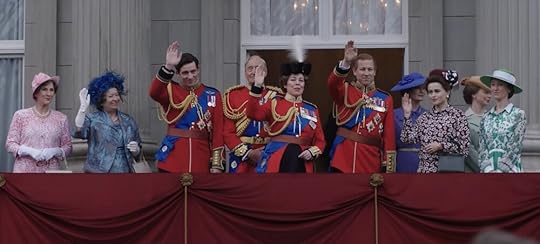

Olivia Colman as The Queen in the Trooping the Colour on The Crown vs. Real life Queen in the Trooping the Colour
So let’s jump right into it, shall we? I’m going to assume if you’re reading this, you’re caught up on who all the main characters are and what’s happened previously in The Crown.
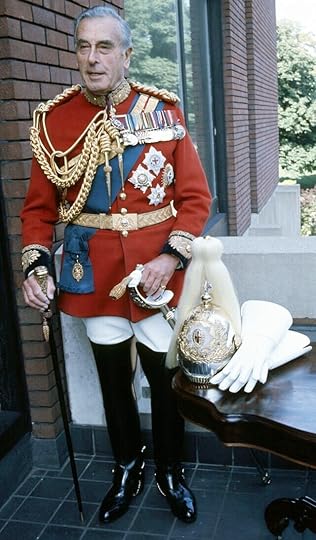
Lord Mountbatten and his gold stick.
“Gold Stick” starts off with the Trooping the Colour, an annual ceremony performed by the British and Commonwealth infantry regiments that also marks the official birthday of the British sovereign (which currently is in June). The queen rides out with the infantry (on horseback until the late 80s, which she switched to riding in a carriage), and then inspects her troops; much of the troops march past the queen and salute her. (There’s a LOT more to this ceremony, but as I don’t know much about British military traditions or terminology, I’m keeping it super simple). (Sidenote: my now-husband and I ended up in London on the official birthday of the British sovereign on accident back in 2013, and I’m pretty sure we saw a bit of the Trooping the Colour ceremony without having any idea of what we were looking at! My royals obsession developed many years later, lol).
In this opening scene, we’ve got the Queen, Prince Philip, Prince Charles, and Lord Mountbatten all on horseback in the ceremony. This feels just like a fancy way of starting the season off initially, but the significance of this scene becomes more apparent over the episode.
First, the name of this episode is “Gold Stick,” which refers to both a ceremonial bodyguard office (the office of Gold Stick in Waiting) and the actual gold stick held by the person in that office. Those in this office attend all state occasions and rides at the sovereign’s side. Lord Mountbatten was appointed Gold Stick in Waiting in 1965 and I believe, served in that role until his death in 1979. I can’t find a list of office holders anywhere, but the Princess Royal, Anne, has apparently served in that position since 1999.
Because this episode ends up being quite significantly about Lord Mountbatten’s death, it’s quite fitting that the episode starts with him formally serving in his role as Gold Stick in Waiting at the queen’s side. The Gold Stick itself is laid on top of Mountbatten’s coffin at his funeral, along with his ceremonial sword and admiral’s hat.
Second, the Trooping the Colour Ceremony was the site of a….sort of assassination attempt on Elizabeth II in 1981. A 17-year-old fired six shots during the ceremony, but it was quickly revealed that they were blanks. It was still a pretty significant event and given the foreboding air of the Season 4 trailers and the centrality of the Trooping the Colour shots in all the promotion, I honestly somewhat expected to see that event in this season. Even if they don’t end up showing that incident though, placing a trooping the colour ceremony at the beginning of an episode all about the assassination of a member of the British royal family is a pretty subtle but distinct reference to it, particularly since the ceremony in the show has IRA propaganda audio playing throughout.
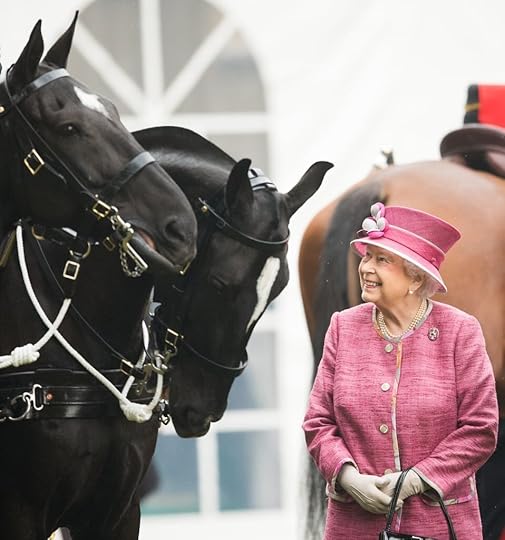
I want someone to look at me the way Queen Elizabeth II looks at horses. Someone tell my husband this.
There’s a lovely little tiny scene before the ceremony is even shown that just shows the Queen fondly interacting with her horse. As was established in Season 3 (in the Lord Mountbatten focused episode of that season, actually!), the Queen legitimately LOVES horses. Just so much. Here’s a photo showing how much she loves horses. Look at that love. <3
ADDED 11/18 (I promised I’d research Charles’ love live, and I have! Here ya go!): After The Trooping the Colours, the royal family gathers for a light meal and gossip about Charles. They quickly discuss several women that Charles has been dating, but don’t really get into the details of who any of them were, referring to them instead in a kind of shorthand. I was able to figure out who most of them were, but not who “Westmorland” or “a Borgia” referred to. Please help me if you know!
I’m happy to share the information about these women here, but I feel uncomfortable sharing paparazzi photos of women who were mostly only very briefly connected to the prince over forty years ago, as it feels just….very male gaze-y. You can easily google photos of these women if you like though.
Westmorland Girl – no idea who this is referring to.
A Guinness – Sabrina Guinness, from the brewing family. She later went on to date Mick Jagger and David Bowie. She did not marry until 2014, when she married playwright Sir Tom Stoppard.
Girl in a bathing costume – This may be referring to model Jane Priest, who was pictured with Charles, both wearing bathing suits, in Australia in 1979. She kissed him on the cheek at the beach in a picture where he looks adorably confused. She claimed later that her hanging out on the beach was actually a PR thing to make the prince appear less stuffy and more relatable.
Longman – Caroline Longman – her mother Lady Elizabeth Lambert was one of the bridesmaids at the Queens’ wedding in 1947.
“Whip?” “Whiplash” – referring to Anna Wallace, the daughter of a Scottish landowner with a notoriously firey temper. She dumped him after he ignored her at not one, but two formal events he invited her to – the Queen Mother’s 80th birthday party and some sort of polo party. Charles supposedly proposed to her twice. He actually dated her in 1980, right before dating Diana.
A Borgia! – no idea.
Sarah Spencer – Diana’s older sister. They dated briefly in 1977 until she talked about their relationship in the press in a negative light, saying she wouldn’t marry Charles “if he were the dustman of the King of England.”
A few other important women Charles dated:
Amanda Knatchbull – Lord Mountbatten’s granddaughter (remember, he was Charles’s great-uncle, so although he was related to Amanda, it was a distant relation). They bonded after Dickie and Amanda’s little brother were killed in the IRA attack. Charles apparently proposed to her in 1980 but she didn’t accept. They saw each other frequently between 1974 and 1979. Dickie apparently really did push for their relationship in his life. She went on to work as a social worker and married someone else and is apparently quite happy out of the limelight.
Jane Wellesley – Daughter of the 8th Duke of Wellington, was considered a leading contender for Charles’ wife for a while. Dated in 1973-1974 and then broke up, possibly due to intense media scrutiny. Famously said: “Do you honestly believe I want to be queen?”
Davina Sheffield – The granddaughter of 1st Lord McGowan, linked to Charles in 1976. Her former boyfriend talked to the press about their relationship and ruined her “virginal” reputation, pretty much putting a stop to their relationship.
Costuming note: At the post-trooping the colors family dinner, every woman at the table is wearing a floral print - the Queen, Princess Anne, the Queen Mother, and Princess Margaret. Sarah Spencer is also in florals when Charles arrives at her house. And then you have Diana appear, dressed as a literal woodland fairy. Floral prints were EVERYWHERE in the 1970s, but I like that it seems to foreshadow Diana’s entrance anyway.
Added 11/18: The fact that Diana meets Charles while dressed like a woodland fairy and they discuss A Midsummer Night’s Dream upon their first meeting foreshadows all the descriptions of their love story as a fairy tale. In real life, Diana said that she met Prince Charles out in a field while her family was hunting with him.
Diana tells Charles that she’s trying to stay out of the way and not be seen, but Sarah later said that Diana was obsessed with meeting Charles. Charles promises Diana not to tell her sister that he’d seen her, but then immediately tells Sarah about their meeting. This sets a precedent for Diana’s life - which was filled with lots of contradictory stories from her point of view vs. Charles and Camilla’s points of view.
As Charles rides away with Sarah, Diana sits in the window sill very gracefully and watches him ride away, pointing to her ballet training.
According to Diana: Her True Story in Her Own Words, Diana enjoyed dancing in the front hall of Althorpe Hall surrounded by portraits of her ancestors, where she’s shown meeting Charles in this episode.
Timing Notes: I have a theory that Season 4 picked up only a few days after Season 3 left off, but then jumped two years between the opening Trooping the Colours/Charles meeting Diana scenes and the election of Margaret Thatcher.
Evidence: Season 3 ended with The Queen’s Silver Jubilee, which occurred in June 1977, with a big procession and Service of Thanksgiving on June 7, 1977. Although the date of the Trooping the Colour ceremony isn’t specifically stated, we know the ceremony occurs on the second Saturday of each June. Immediately after this scene in the show, Prince Charles drives off to hang out with Sarah Spencer (who he’s currently dating) and meets Diana for the first time. We know that historically, Charles dated Sarah IN 1977, and met Diana that same year (when Diana was 16). And Margaret Thatcher was elected prime minister in Mary 1979. ADDED 11/18: On a later watch, I noticed that some of the Ireland protest scenes in the Trooping the Colours scene featured signs stating that the queen had been on the throne from 1952-1977 - indicating further that the pre-credits sequence took place in 1977.
You MAY ASK - well, but what about all those girls Charles supposedly dated - that his family was discussing immediately after the Trooping the Colour? Although Season 3 made it look like the Silver Jubilee was celebrated pretty shortly after Camilla Shand married Andrew Parker-Bowles, in real life, Camilla’s wedding occurred in 1973. Charles has definitely had many years to date whoever he wants.
Anyway, it may not matter to anyone else, but I’m very much enjoying this theory of mine and am sticking by with it.
They pinned down Thatcher’s look SO EXACTLY. Check out the side by side of Gillian Anderson as Thatcher and real life Thatcher.

Gillian Anderson as Margaret Thatcher on The Crown vs. Margaret Thatcher in Real Life
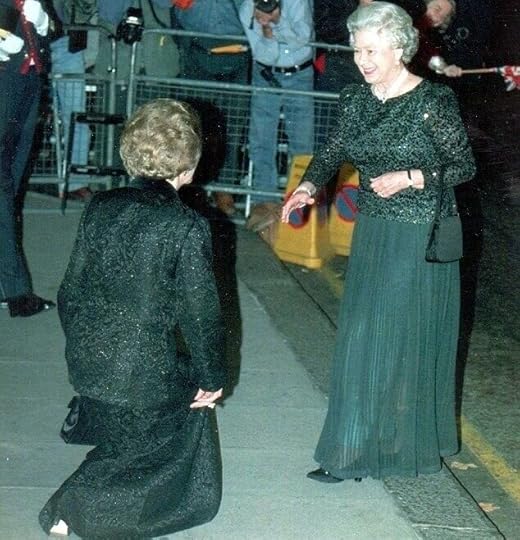
Margaret Thatcher awkwardly curtseying to the Queen. “Please, please stop doing that.”
When Margaret Thatcher meets the queen, she curtsies in a very elaborate way. The Queen’s eyes get slightly wider at the sight. This apparently was a known quirk of Thatcher’s. Check out this photo I found of her curtseying.
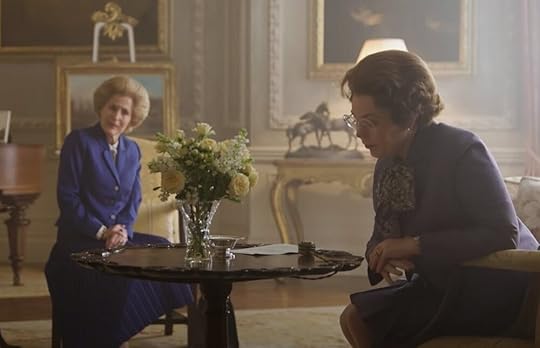
When the Queen meets Thatcher, they’re wearing almost exactly the same outfit, as they both sport colorful skirt suits with floral pussy bow blouses and sensible heels. Elizabeth is in light purple with a floral blouse, Margaret is in bright blue with a light blue and white blouse. Margaret Thatcher DID indeed wear skirt suits and pussy bow blouses constantly, and the Queen wore pussy bow blouses a few times in the 70s. I’m wondering if they took advantage of the common historical fashion similarities between the characters as a jumping off point to indicate how much in common they really have - a point which Elizabeth made to Philip in an earlier scene, as she was watching the election returns, and which Margaret made in a later scene, to her own husband. Their similarities are also highlighted by the fact that first Prince Philip, and then Denis Thatcher, make somewhat derogatory jokes about two middle-aged women holding the two highest offices in the country.
Thatcher says to the queen: "I find women in general are not suited to high office. ...I find they are too emotional." There’s no evidence that said nothing of the sort in real life, but she wasn’t exactly an ardent supporter of women in high office. She was prime minister for over a decade but only every appointed one woman to cabinet and one woman as the vice chair of the Conservative party.
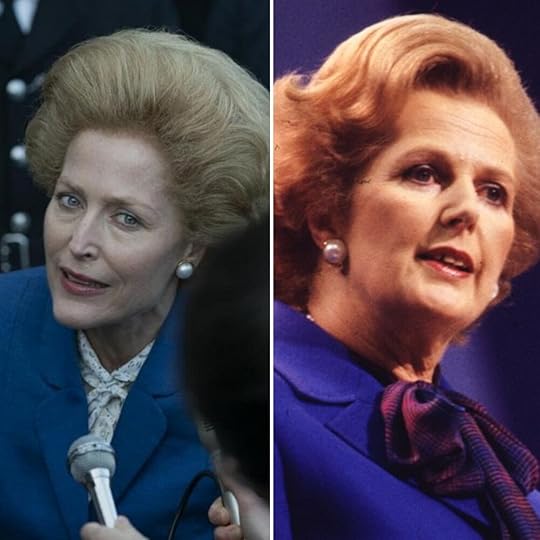
Gillian Anderson as Margaret Thatcher on The Crown vs. Margaret Thatcher in Real Life
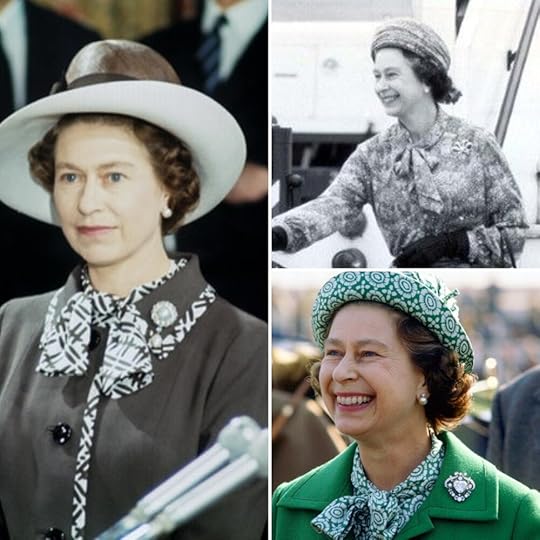
The Queen sporting various pussy bow blouses.
The one odd note about the scene in which they meet is that the costume notably made the queen look a bit frumpy? Is this to indicate the slight nervousness she was showing before Thatcher walked in the room, messing with the flowers in front of her and all that? They made her look wider at the waist, although lots of photos from the late 70s early 80s show that the Queen was absolutely not that wide then and maybe not even now.
I have no idea if the Queen actually likes to guess the cabinet members before they’re picked (I haven’t found any evidence of that, and given how confidential her conversations are with her prime ministers, we’d really have no way of knowing) but that was a fantastic scene.
Later, on the way to Balmoral, we see Princess Anne arguing in a car with a man we’ve never seen before, who later is revealed in conversation with her father to be her husband, Mark Phillips. They discuss Anne potentially withdrawing from show jumping, and it’s implied that this is partly to get away from her husband, although she doesn’t really elaborate on their marriage issues.
Anne really was and is a brilliant equestrian and competed in the 1976 Olympic Games in Montreal as a member of the British team, riding the Queen’s horse, Goodwill (This is also the name of the horse she rides in the show jumping scene later in the episode). Anne actually met her husband at an equestrian party. Mark was on the Olympic equestrian teams in 1972 and 1988 and was a reserve team member in 1968.
They didn’t show Anne’s wedding or kidnapping attempt sadly, but at the time of the first episode of season 4, Anne would have been married to mark Phillips for almost 6 years. They would have had a 2 year old son by this first episode as well.
The scene showing prince Phillip talking with princess anne – do those actors ACTUALLY look that much alike or did the show do something to their noses to make them look more similar? It’s insane.
In this scene, Anne says she’s been on her backside most of the year, instead of on a horse, and says something cryptic about having “a case of the horrors on a horse.” Being on her backside may have been a reference to her having children. I don’t know why she would be afraid of riding though? She did have a pretty bad fall from a horse in the 80s, but this happens chronologically before that. I’ll do more research on this and see if I can find an answer.
We see a scene of Lord Mountbatten talking to Prince Charles on the phone, discussing his continuing relationship with Camilla. I don’t believe there’s any evidence of Charles having an affair with Camilla at this time actually, although they were certainly friends during her marriage to Andrew. Charles actually was godfather to her son Tom, born in 1974. Charles’ authorized biography indicates that he began an affair with Camilla in 1986 though, several years into his marriage to Diana.
Within the conversation, Charles refers to Dickie’s own slightly disastrous marriage with “consequences on national security,” which was briefly shown in Season 1/2 of the Crown, and says that Camilla’s husband is having affairs of his own. It does appear to be accepted fact that Parker Bowles DID have lots of affairs.
Mountbatten’s marriage was apparently not a very happy one, and Edwina apparently had many many affairs. They apparently agreed to an open marriage after a while. He even once stated, “Edwina and I spent all our married lives getting into other people’s beds.” There’s some evidence indicating that Dickie was bisexual, and unfortunately, some very nasty allegations of pedophilia. I’m not entirely certain what national security concerns Charles specifically is referring to here, but his comment most likely refers to Edwina’s relationship with Pandit Nehru, India’s first prime minister after the country’s independence. I honestly don’t know enough about British-Indian relationships in the 1940s to say more than that.
Even though Charles and Camilla likely weren’t seeing each other at the time of Mountbatten’s death, I can understand why it was used in the show as a way to build tension and to underline Charles’s determination to find a good wife.
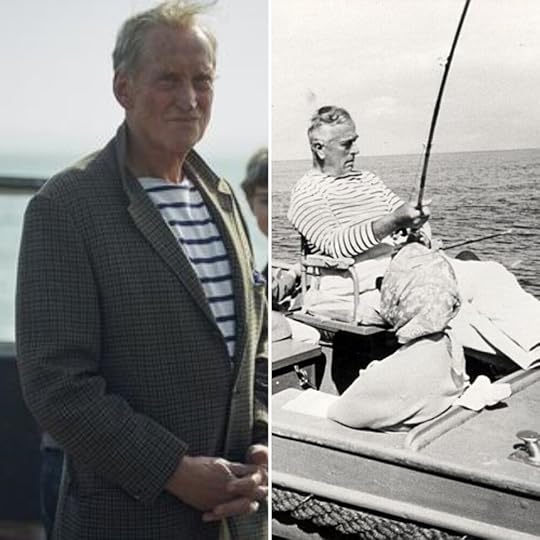
Charles Dance as Lord Mountbatten about to go lobster fishing vs. real life Lord Mountbatten on his boat.
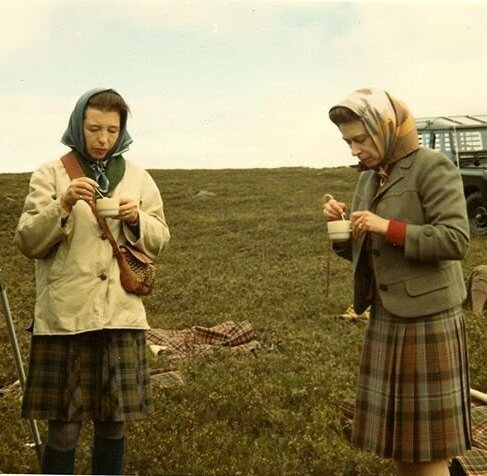
I couldn’t find a screenshot from The Crown of the Queen and Anne stalking, but if you’ve seen this episode, you’ll see how similar their stalking outfits are to their real life counterparts’ outfits in this pic.
The sequence in which we see Charles fishing, Anne and the Queen stalking, Philip hunting off by himself alone, and Dickie going out on the lake with his daughter and grandkids is beautifully done and quite haunting, as even if you don’t really know what’s going to happen, tension builds with the occasional gunshots and the plotting bad guys in the car pointing out Dickie’s boat. Lord Mountbatten really was lobster fishing with his family when the bomb went off, and the pairing of the other royals’ well established animal death related sporting activities with his really ties them all together as a family and ties them together with a bit of foreboding.
As mentioned in the show, Mountbatten’s grandsons were on the boat with him and one of them died. His surviving grandson, Timothy Knatchbull, has written a book about the incident.
Lord Mountbatten’s fishing look is pretty accurate to real life.
I’m really sad we don’t get any more Charles Dance in this show. He’s just so good in this role.
The sequence of all the secretaries going to find and tell their royal family members the news broke my heart a little. The fact that it’s long-time royal secretary Martin Charteris who’s telling the queen (who had definitely retired before this incident in real life, but is still around on the show), is just….so meaningful and heart rending and sad.
The queen’s reaction to multiple cars coming out to find her hunting (“oh dear. It’s never good when they come in packs like this.”) just continues the hunting and animal references in these few scenes.
Charles really was in Iceland when Mountbatten was assassinated. He apparently wrote in his journal then: “Life will never be the same now that he has gone and I fear it will take me a very long time to forgive those people who today achieved something that two world wars and thousands of Germans and Japanese failed to achieve.”
Charles receives the letter Dickie wrote him right before his death while he’s flying back to England for the funeral. The letter essentially tells him to go find a virginal wife, someone who has no past and knows the rules. The show’s depiction of Mountbatten’s attitude on Charles’ love life appears to be pretty accurate, as he apparently did tell Charles to “have as many affairs as he can,” but also emphasized that his future wife needed to be a virgin, writing in a letter, “I think it is disturbing for women to have experiences if they have to remain on a pedestal after marriage.”
Margaret Thatcher’s words to the queen on the phone are almost exactly what she said in real life. The Crown has such an eye for detail; I love that Thatcher quickly snaps off her right earring before she picks up the phone.
The Crown: “This is a very great tragedy. Lord Mountbatten’s death leaves a gap that can never be filled. Our heartfelt condolences go out to you and your family, and of course of those of the servicemen killed at Warrenpoint today. …” She then goes on to condemn the IRA and promises to defeat them.
Real life - “His death leaves a gap that can never be filled. The British people give thanks for his life and grieve at his passing.”
The show only refers to the Warrenpoint incident in passing, but on the same day as Mountbatten’s assassination, the IRA ambushed a British Army convoy with two roadside bombs right outside Warrenpoint, Northern Ireland. 18 soldiers were killed and over 20 were seriously injured. It was the deadliest attack on the British Army during the Troubles.
As explained later in the episode, in audio of IRA speeches over Mountbatten’s funeral footage, the attack at Warrenpoint and on Mountbatten was intended as retaliation for the deaths of 13 unarmed civilians during a protest march in Derry in 1972, an incident known as Bloody Sunday. Graffiti did start appearing in known republican areas of Northern Ireland that said “13 gone and not forgotten, we got 18 and Mountbatten,” which is used as a direct quote in the show.
Philip and Charles, the people closest to Lord Mountbatten, yet again demonstrate their complicated relationship when the tipsy?drunk? Philip tells Charles that he’s doing the reading at Dickie’s funeral. Philip bitterly complains that Dickie ended up replacing Philip as a father figure to Charles and Charles replaced Philip as a son figure to Dickie. Season 3 didn’t really focus much on Philip’s issues with Charles, which haven’t been addressed in full since S2E9 Paterfamilias (showing both Philip’s and Charles’ experiences at Gordonstoun).
As Dickie was a surrogate father figure to Philip, Philip gets angry at Charles for suggesting that Dickie was a father figure to him too “What are you talking about? You have a father, you have a father.” Philip is clearly a couple glasses of whiskey in already.
Philip’s closed off attitude toward any sign of emotion is demonstrated both through his obvious inebriation and his statement that “he would have hated any mawkish outpourings of grief or sentimentality.” This repeats similar sentiments to those he expressed in S3E7 Moondust, when he told a group of priests in the midst of mid-life crises, “I’ve never heard such a load of pretentious self pitying nonsense. What you lot need to do is get off your backsides, get out into the world, and do something. That is why you are all so lost.”
According to the show, Mountbatten left 500 PAGES OF INSTRUCTIONS for the funeral. In real life, he did have it all planned out in detail, although I don’t know if we have an exact page number.
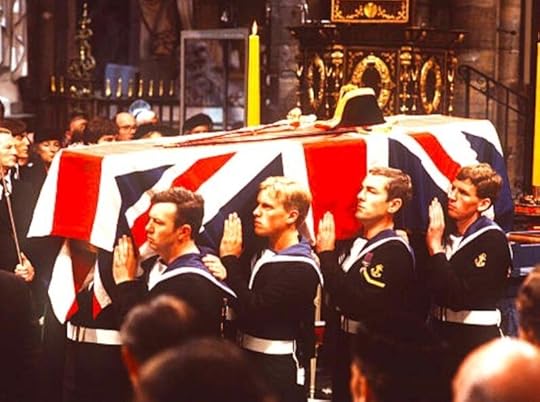
Lord Mountbatten’s funeral in real life, featuring the eponymous gold stick.
Mountbatten’s funeral in The Crown looks almost exactly like pictures from his real funeral; the casket and layout of hat and swords on top is just like it was in real life.
The IRA audio over the funeral also said: “To Irish Republicans, Lord Mountbatten was the ultimate symbol of imperialist oppression. Each year he came to sit in his castle on land stolen by the English. He knew the risks in coming here, and his death represents a legitimate blow against an enemy target.” This audio strikes in contrast to the trooping the colour ceremony at the beginning, and the imperialist sentiments implied by such a ceremony.
Charles really did read Psalm 107 at Mountbatten’s funeral, which does specifically refer to those on the sea and God stilling the storm and the waves. Seems very appropriate.
The last shot of the funeral scene is coffin shaped, with a view up from the bottom toward the Queen, Philip, and Charles looking down at it. It’s very dark.
The strife between Philip and Charles continues later, as Charles comes to Anne’s show jumping contest but only comes forward to talk to his mother after his father walks away. They speak very very briefly, but mostly avoid each other.
Anne’s show jumping scene is lovely but I really don’t have much to say about it because I know nothing about horses, sorry. It clearly is meant to show her getting over her fear of riding horses again, but that fear isn’t really explained in the first place, so it’s hard to get very attached to this story line.
I guess there’s a carnival going on outside the show jumping contest? Is that a thing? Anyway, there’s like carnival music and rides in the background as Charles drives away and meets Diana again, where she expresses sympathy on the death of Lord Mountbatten and compliments him on his handling of the reading at the funeral. He’s fully able to see her face this time, and she’s sporting a young-looking yellow overalls outfit that is very close to one of her real life outfits.
It does seem to highlight both the carnival atmosphere and her youth, which is highlighted in the next scene when Charles calls Sarah Spencer to interrogate her about her sister. It appears that Charles, wearing a bowtie and suit, is calling Sarah from a party, and it’s clearly implied by the noise around her that Sarah is also at a party when she answers.
In real life, after Charles and Sarah stopped seeing each other, he didn’t see Diana again until 1980, when they were both at the same house party. They apparently did talk about Mountbatten’s death and Charles’ role at the funeral, but according to Diana, she was a lot less tactful in real life (quote taken from a tape used in the documentary Diana: In her Own Words). "We were talking about Mountbatten and his girlfriend and I said, ‘You must be so lonely.’ I said, ‘It’s pathetic watching you walking up the aisle with Mountbatten’s coffin in front, ghastly, you need someone beside you.’ Whereupon he leapt upon me and started kissing me and I thought, urgh, this is not what people do. And he was all over me for the rest of the evening, following me around like a puppy.”
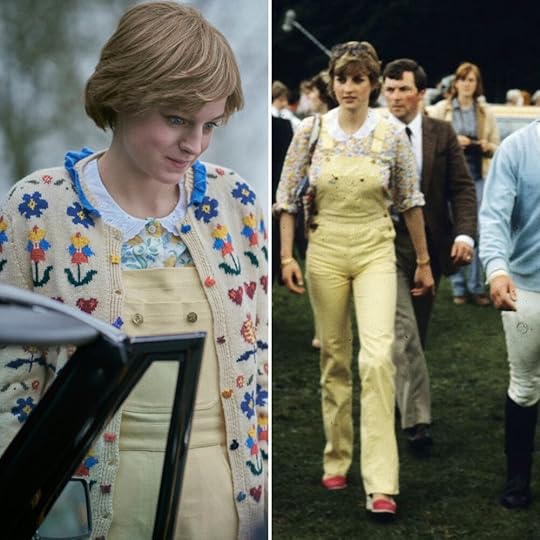
Emma Corrin as Diana, later Princess of Wales, in The Crown vs. real life Diana, Princess of Wales.
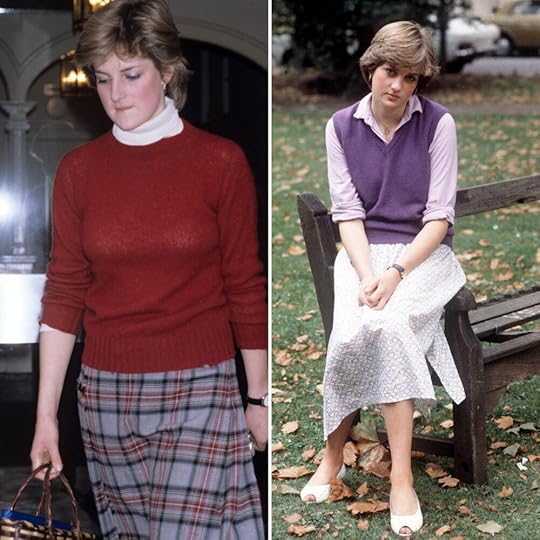
Diana, Princess of Wales sporting two sweater and skirt combinations similar to that seen in the show.
Enough time has passed since Charles and Sarah dated that she is now engaged and has invited him to her wedding, which he politely declines at the beginning of his phone call. This totally supports my “S4E1 starts in 1977 and then jumps to 1979” theory, lol (but not really, because people can get engaged much quicker than that, obviously).
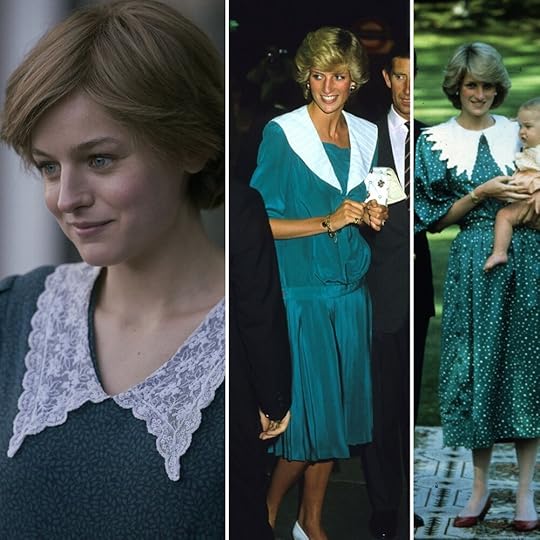
Emma Corrin as Diana, later Princess of Wales, in The Crown vs. real life Diana, Princess of Wales.
Sidenote: Apparently Sarah’s relationship with Charles did NOT end well, as she talked with reporters and reportedly said that she would not marry Charles “if he were the dustman or the King of England.” Supposedly, she showed Charles the article in which this quote appeared and he got rather angry, saying “You’ve just done something incredibly stupid.” She later took credit for introducing her sister to Charles though, and served as one of her ladies-in-waiting.
In the show Sarah tells Charles that the family calls Diana Duch “because ever since childhood she’s behaved as if she were destined for greater things.” This is true, and apparently as Duch instead of Diana.
I couldn’t find a screenshot of Diana’s sweater and skirt outfit that appears on screen when Sarah is describing her to Charles, but it looked pretty similar to several sweater and skirt outfits Diana wore in real life.
The dress Diana is wearing when Charles pulls up for their date is very very similar to two she wore in real life.
It’s funny, Emma Corrin doesn’t really LOOK that much like Princess Diana, but somehow feels very much like Diana. Is it the youth? The smile? The way she holds herself? Hard to tell. But it just feels like very good casting.
Overanalyzing The Crown S4E1: Gold Stick
This post is part of a series on Season 4 of The Crown. All my posts on The Crown are available here !
Since I had great fun over-analyzing every episode of Season 3 of The Crown last year, I’m doing the same thing this year! I’ll be /trying/ to write these posts up one episode at a time (although I may watch ahead a bit of my writing), so there won’t be spoilers for any episode except that which I’m covering in the post. So if you haven’t watched Season 4 Episode 1 of the Crown yet and don’t want to be spoiled, please stop reading now. :)

Olivia Colman as The Queen in the Trooping the Colour on The Crown vs. Real life Queen in the Trooping the Colour
So let’s jump right into it, shall we? I’m going to assume if you’re reading this, you’re caught up on who all the main characters are and what’s happened previously in The Crown.
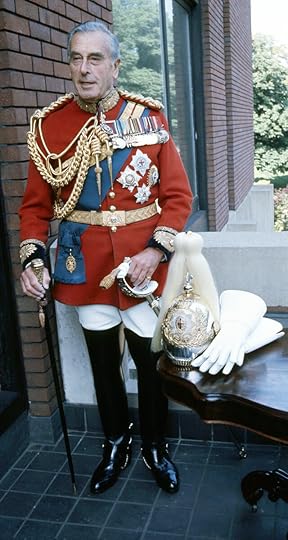
Lord Mountbatten, holding his gold stick.
“Gold Stick” starts off with the Trooping the Colour, an annual ceremony performed by the British and Commonwealth infantry regiments that also marks the official birthday of the British sovereign (which currently is in June). The queen rides out with the infantry (on horseback until the late 80s, which she switched to riding in a carriage), and then inspects her troops; much of the troops march past the queen and salute her. (There’s a LOT more to this ceremony, but as I don’t know much about British military traditions or terminology, I’m keeping it super simple). (Sidenote: my now-husband and I ended up in London on the official birthday of the British sovereign on accident back in 2013, and I’m pretty sure we saw a bit of the Trooping the Colour ceremony without having any idea of what we were looking at! My royals obsession developed many years later, lol).
In this opening scene, we’ve got the Queen, Prince Philip, Prince Charles, and Lord Mountbatten all on horseback in the ceremony. This feels just like a fancy way of starting the season off initially, but the significance of this scene becomes more apparent over the episode.
First, the name of this episode is “Gold Stick,” which refers to both a ceremonial bodyguard office (the office of Gold Stick in Waiting) and the actual gold stick held by the person in that office. Those in this office attend all state occasions and rides at the sovereign’s side. Lord Mountbatten was appointed Gold Stick in Waiting in 1965 and I believe, served in that role until his death in 1979. I can’t find a list of office holders anywhere, but the Princess Royal, Anne, has apparently served in that position since 1999.
Because this episode ends up being quite significantly about Lord Mountbatten’s death, it’s quite fitting that the episode starts with him formally serving in his role as Gold Stick in Waiting at the queen’s side. The Gold Stick itself is laid on top of Mountbatten’s coffin at his funeral, along with his ceremonial sword and admiral’s hat.
Second, the Trooping the Colour Ceremony was the site of a….sort of assassination attempt on Elizabeth II in 1981. A 17-year-old fired six shots during the ceremony, but it was quickly revealed that they were blanks. It was still a pretty significant event and given the foreboding air of the Season 4 trailers and the centrality of the Trooping the Colour shots in all the promotion, I honestly somewhat expected to see that event in this season. Even if they don’t end up showing that incident though, placing a trooping the colour ceremony at the beginning of an episode all about the assassination of a member of the British royal family is a pretty subtle but distinct reference to it, particularly since the ceremony in the show has IRA propaganda audio playing throughout.

I want someone to look at me the way Queen Elizabeth II looks at horses. Someone tell my husband this.
There’s a lovely little tiny scene before the ceremony is even shown that just shows the Queen fondly interacting with her horse. As was established in Season 3 (in the Lord Mountbatten focused episode of that season, actually!), the Queen legitimately LOVES horses. Just so much. Here’s a photo showing how much she loves horses. Look at that love.
I’m not going back and obsessively writing down every girl referenced in the royal family’s discussion of Charles’s love right now, because I am trying to get this post up quickly, but I’ll do so later and figure out who all they’re talking about then. In the meantime, here’s an article link talking about how much Charles dated in the 70s.
Timing Notes: I have a theory that Season 4 picked up only a few days after Season 3 left off, but then jumped two years between the opening Trooping the Colours/Charles meeting Diana scenes and the election of Margaret Thatcher.
Evidence: Season 3 ended with The Queen’s Silver Jubilee, which occurred in June 1977, with a big procession and Service of Thanksgiving on June 7, 1977. Although the date of the Trooping the Colour ceremony isn’t specifically stated, we know the ceremony occurs on the second Saturday of each June. Immediately after this scene in the show, Prince Charles drives off to hang out with Sarah Spencer (who he’s currently dating) and meets Diana for the first time. We know that historically, Charles dated Sarah IN 1977, and met Diana that same year (when Diana was 16). And Margaret Thatcher was elected prime minister in Mary 1979.
You MAY ASK - well, but what about all those girls Charles supposedly dated - that his family was discussing immediately after the Trooping the Colour? Although Season 3 made it look like the Silver Jubilee was celebrated pretty shortly after Camilla Shand married Andrew Parker-Bowles, in real life, Camilla’s wedding occurred in 1973. Charles has definitely had many years to date whoever he wants.
Anyway, it may not matter to anyone else, but I’m very much enjoying this theory of mine and am sticking by with it.
They pinned down Thatcher’s look SO EXACTLY. Check out the side by side of Gillian Anderson as Thatcher and real life Thatcher.

Gillian Anderson as Margaret Thatcher on The Crown vs. Margaret Thatcher in Real Life

Margaret Thatcher awkwardly curtseying to the Queen. “Please, please stop doing that.”
When Margaret Thatcher meets the queen, she curtsies in a very elaborate way. The Queen’s eyes get slightly wider at the sight. This apparently was a known quirk of Thatcher’s. Check out this photo I found of her curtseying.
When the Queen meets Thatcher, they’re wearing almost exactly the same outfit, as they both sport colorful skirt suits with floral pussy bow blouses and sensible heels. Elizabeth is in light purple with a green and white floral blouse, Margaret is in bright blue with a light blue and white blouse. Margaret Thatcher DID indeed wear skirt suits and pussy bow blouses constantly, and the Queen wore pussy bow blouses a few times in the 70s. I’m wondering if they took advantage of the common historical fashion similarities between the characters as a jumping off point to indicate how much in common they really have - a point which Elizabeth made to Philip in an earlier scene, as she was watching the election returns, and which Margaret made in a later scene, to her own husband.

Gillian Anderson as Margaret Thatcher on The Crown vs. Margaret Thatcher in Real Life

The Queen sporting various pussy bow blouses.
The one odd note about the scene in which they meet is that the costume notably made the queen look a bit frumpy? Is this to indicate the slight nervousness she was showing before Thatcher walked in the room, messing with the flowers in front of her and all that? They made her look wider at the waist, although lots of photos from the late 70s early 80s show that the Queen was absolutely not that wide then and maybe not even now.
I have no idea if the Queen actually likes to guess the cabinet members before they’re picked (I haven’t found any evidence of that, and given how confidential her conversations are with her prime ministers, we’d really have no way of knowing) but that was a fantastic scene.
Later, on the way to Balmoral, we see Princess Anne arguing in a car with a man we’ve never seen before, who later is revealed in conversation with her father to be her husband, Mark Phillips. They discuss Anne potentially withdrawing from show jumping, and it’s implied that this is partly to get away from her husband, although she doesn’t really elaborate on their marriage issues.
Anne really was and is a brilliant equestrian and competed in the 1976 Olympic Games in Montreal as a member of the British team, riding the Queen’s horse, Goodwill (This is also the name of the horse she rides in the show jumping scene later in the episode). Anne actually met her husband at an equestrian party. Mark was on the Olympic equestrian teams in 1972 and 1988 and was a reserve team member in 1968.
They didn’t show Anne’s wedding or kidnapping attempt sadly, but at the time of the first episode of season 4, anne would have been married to mark Phillips for almost 6 years. They would have had a 2 year old son by this first episode as well.
The scene showing prince Phillip talking with princess anne – do those actors ACTUALLY look that much alike or did the show do something to their noses to make them look more similar? It’s insane.
We see a scene of Lord Mountbatten talking to Prince Charles on the phone, discussing his continuing relationship with Camilla. I don’t believe there’s any evidence of Charles having an affair with Camilla at this time actually, although they were certainly friends during her marriage to Andrew. Charles actually was godfather to her son Tom, born in 1974. Charles’ authorized biography indicates that he began an affair with Camilla in 1986 though, several years into his marriage to Diana.
Within the conversation, Charles refers to Dickie’s own slightly disastrous marriage with “consequences on national security,” which was briefly shown in Season 1/2 of the Crown, and says that Camilla’s husband is having affairs of his own. It does appear to be accepted fact that Parker Bowles DID have lots of affairs.
Mountbatten’s marriage was apparently not a very happy one, and Edwina apparently had many many affairs. They apparently agreed to an open marriage after a while. He even once stated, “Edwina and I spent all our married lives getting into other people’s beds.” There’s some evidence indicating that Dickie was bisexual, and unfortunately, some very nasty allegations of pedophilia. I’m not entirely certain what national security concerns Charles specifically is referring to here, but his comment most likely refers to Edwina’s relationship with Pandit Nehru, India’s first prime minister after the country’s independence. I honestly don’t know enough about British-Indian relationships in the 1940s to say more than that.
Even though Charles and Camilla likely weren’t seeing each other at the time of Mountbatten’s death, I can understand why it was used in the show as a way to build tension and to underline Charles’s determination to find a good wife.

Charles Dance as Lord Mountbatten about to go lobster fishing vs. real life Lord Mountbatten on his boat.

I couldn’t find a screenshot from The Crown of the Queen and Anne stalking, but if you’ve seen this episode, you’ll see how similar their stalking outfits are to their real life counterparts’ outfits in this pic.
The sequence in which we see Charles fishing, Anne and the Queen stalking, Philip hunting off by himself alone, and Dickie going out on the lake with his daughter and grandkids is beautifully done and quite haunting, as even if you don’t really know what’s going to happen, tension builds with the occasional gunshots and the plotting bad guys in the car pointing out Dickie’s boat. Lord Mountbatten really was lobster fishing with his family when the bomb went off, and the pairing of the other royals’ well established animal death related sporting activities with his really ties them all together as a family and ties them together with a bit of foreboding.
As mentioned in the show, Mountbatten’s grandsons were on the boat with him and one of them died. His surviving grandson, Timothy Knatchbull, has written a book about the incident.
Lord Mountbatten’s fishing look is pretty accurate to real life.
I’m really sad we don’t get any more Charles Dance in this show. He’s just so good in this role.
The sequence of all the secretaries going to find and tell their royal family members the news broke my heart a little. The fact that it’s long-time royal secretary Martin Charteris who’s telling the queen (who had definitely retired before this incident in real life, but is still around on the show), is just….so meaningful and heart rending and sad.
The queen’s reaction to multiple cars coming out to find her hunting (“oh dear. It’s never good when they come in packs like this.”) just continues the hunting and animal references in these few scenes.
Charles really was in Iceland when Mountbatten was assassinated. He apparently wrote in his journal then: “Life will never be the same now that he has gone and I fear it will take me a very long time to forgive those people who today achieved something that two world wars and thousands of Germans and Japanese failed to achieve.”
Charles receives the letter Dickie wrote him right before his death while he’s flying back to England for the funeral. The letter essentially tells him to go find a virginal wife, someone who has no past and knows the rules. The show’s depiction of Mountbatten’s attitude on Charles’ love life appears to be pretty accurate, as he apparently did tell Charles to “have as many affairs as he can,” but also emphasized that his future wife needed to be a virgin, writing in a letter, “I think it is disturbing for women to have experiences if they have to remain on a pedestal after marriage.”
Margaret Thatcher’s words to the queen on the phone are almost exactly what she said in real life.
The Crown: “This is a very great tragedy. Lord Mountbatten’s death leaves a gap that can never be filled. Our heartfelt condolences go out to you and your family, and of course of those of the servicemen killed at Warrenpoint today. …” She then goes on to condemn the IRA and promises to defeat them.
Real life - “His death leaves a gap that can never be filled. The British people give thanks for his life and grieve at his passing.”
The show only refers to the Warrenpoint incident in passing, but on the same day as Mountbatten’s assassination, the IRA ambushed a British Army convoy with two roadside bombs right outside Warrenpoint, Northern Ireland. 18 soldiers were killed and over 20 were seriously injured. It was the deadliest attack on the British Army during the Troubles.
As explained later in the episode, in audio of IRA speeches over Mountbatten’s funeral footage, the attack at Warrenpoint and on Mountbatten was intended as retaliation for the deaths of 13 unarmed civilians during a protest march in Derry in 1972, an incident known as Bloody Sunday. Graffiti did start appearing in known republican areas of Northern Ireland that said “13 gone and not forgotten, we got 18 and Mountbatten,” which is used as a direct quote in the show.
Philip and Charles, the people closest to Lord Mountbatten, yet again demonstrate their complicated relationship when the tipsy?drunk? Philip tells Charles that he’s doing the reading at Dickie’s funeral. Philip bitterly complains that Dickie ended up replacing Philip as a father figure to Charles and Charles replaced Philip as a son figure to Dickie. Season 3 didn’t really focus much on Philip’s issues with Charles, which haven’t been addressed in full since S2E9 Paterfamilias (showing both Philip’s and Charles’ experiences at Gordonstoun).
As Dickie was a surrogate father figure to Philip, Philip gets angry at Charles for suggesting that Dickie was a father figure to him too “What are you talking about? You have a father, you have a father.” Philip is clearly a couple glasses of whiskey in already.
Philip’s closed off attitude toward any sign of emotion is demonstrated both through his obvious inebriation and his statement that “he would have hated any mawkish outpourings of grief or sentimentality.” This repeats similar sentiments to those he expressed in S3E7 Moondust, when he told a group of priests in the midst of mid-life crises, “I’ve never heard such a load of pretentious self pitying nonsense. What you lot need to do is get off your backsides, get out into the world, and do something. That is why you are all so lost.”
According to the show, Mountbatten left 500 PAGES OF INSTRUCTIONS for the funeral. In real life, he did have it all planned out in detail, although I don’t know if we have an exact page number.

Lord Mountbatten’s funeral in real life, featuring the eponymous gold stick.
Mountbatten’s funeral in The Crown looks almost exactly like pictures from his real funeral; the casket and layout of hat and swords on top is just like it was in real life.
The IRA audio over the funeral also said: “To Irish Republicans, Lord Mountbatten was the ultimate symbol of imperialist oppression. Each year he came to sit in his castle on land stolen by the English. He knew the risks in coming here, and his death represents a legitimate blow against an enemy target.” This audio strikes in contrast to the trooping the colour ceremony at the beginning, and the imperialist sentiments implied by such a ceremony.
Charles really did read Psalm 107 at Mountbatten’s funeral, which does specifically refer to those on the sea and God stilling the storm and the waves. Seems very appropriate.
The last shot of the funeral scene is coffin shaped, with a view up from the bottom toward the Queen, Philip, and Charles looking down at it. It’s very dark.
The strife between Philip and Charles continues later, as Charles comes to Anne’s show jumping contest but only comes forward to talk to his mother after his father walks away. Anne’s show jumping scene is lovely but I really don’t have much to say about it because I know nothing about horses, sorry.
I guess there’s a carnival going on outside the show jumping contest? Is that a thing? Anyway, there’s like carnival music and rides in the background as Charles drives away and meets Diana again, where she expresses sympathy on the death of Lord Mountbatten and compliments him on his handling of the reading at the funeral. He’s fully able to see her face this time, and she’s sporting a young-looking yellow overalls outfit that is very close to one of her real life outfits. It does seem to highlight both the carnival atmosphere and her youth, which is highlighted in the next scene when Charles calls Sarah Spencer to interrogate her about her sister.
In real life, after Charles and Sarah stopped seeing each other, he didn’t see Diana again until 1980, when they were both at the same house party. They apparently did talk about Mountbatten’s death and Charles’ role at the funeral, but according to Diana, she was a lot less tactful in real life (quote taken from a tape used in the documentary Diana: In her Own Words). "We were talking about Mountbatten and his girlfriend and I said, ‘You must be so lonely.’ I said, ‘It’s pathetic watching you walking up the aisle with Mountbatten’s coffin in front, ghastly, you need someone beside you.’ Whereupon he leapt upon me and started kissing me and I thought, urgh, this is not what people do. And he was all over me for the rest of the evening, following me around like a puppy.”

Emma Corrin as Diana, later Princess of Wales, in The Crown vs. real life Diana, Princess of Wales.

Diana, Princess of Wales sporting two sweater and skirt combinations similar to that seen in the show.
Enough time has passed since Charles and Sarah dated that she is now engaged and has invited him to her wedding, which he politely declines at the beginning of his phone call. This totally supports my “S4E1 starts in 1977 and then jumps to 1979” theory, lol (but not really, because people can get engaged much quicker than that, obviously).

Emma Corrin as Diana, later Princess of Wales, in The Crown vs. real life Diana, Princess of Wales.
Sidenote: Apparently Sarah’s relationship with Charles did NOT end well, as she talked with reporters and reportedly said that she would not marry Charles “if he were the dustman or the King of England.” Supposedly, she showed Charles the article in which this quote appeared and he got rather angry, saying “You’ve just done something incredibly stupid.” She later took credit for introducing her sister to Charles though, and served as one of her ladies-in-waiting.
In the show Sarah tells Charles that the family calls Diana Duch “because ever since childhood she’s behaved as if she were destined for greater things.” This is true, and apparently as Duch instead of Diana.
I couldn’t find a screenshot of Diana’s sweater and skirt outfit that appears on screen when Sarah is describing her to Charles, but it looked pretty similar to several sweater and skirt outfits Diana wore in real life.
The dress Diana is wearing when Charles pulls up for their date is very very similar to two she wore in real life.
It’s funny, Emma Corrin doesn’t really LOOK that much like Princess Diana, but somehow feels very much like Diana. Is it the youth? The smile? The way she holds herself? Hard to tell. But it just feels like very good casting.
October 28, 2020
Disney Crowns and Tiaras: Historical and Modern Inspirations (Part II)
Related Blog Posts:
Disney Crowns and Tiaras: Historical and Modern Inspirations (Part I) - Snow White, Alice in Wonderland (cartoon and live), Sleeping Beauty/Maleficent, Robin Hood, and the Great Mouse Detective
Diadems, Tiaras, and Crowns, Oh My! - an overview of types, definitions, and purposes
The Classic Disney Influences in the Costumes of "The Descendants”
I decided a while back that I wanted to compare the crowns and tiaras in Disney films to real life crowns and tiaras, posted up one blog post about it in April, and then…nothing for a long time because pandemic depression.
So uh, here is part 2 finally. I’m not saying that these original crowns/tiaras WERE inspirations for those in the films (some actually post date the crowns/tiaras in the films), but am just looking for similarities.
Today, I’m going to look at crowns and tiaras in Cinderella, Little Mermaid, The Princess and the Frog, and The Sword in the Stone!
View fullsize

View fullsize
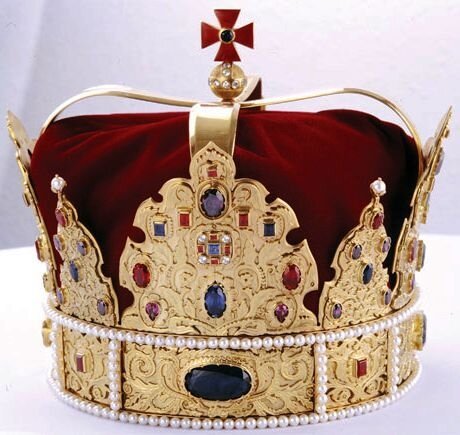
View fullsize
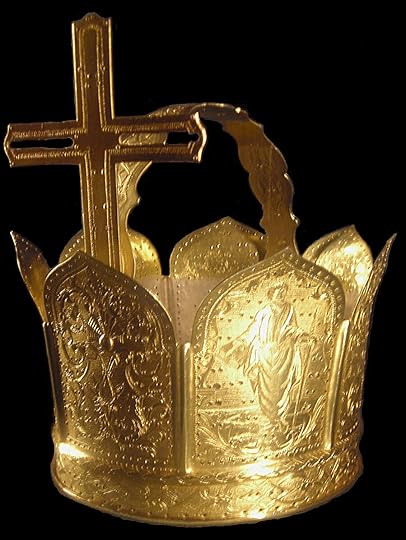
View fullsize
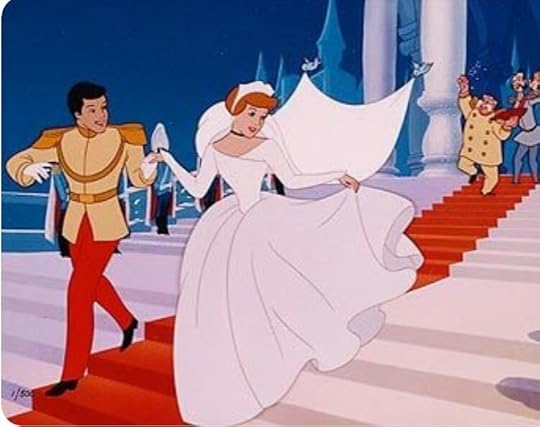
View fullsize
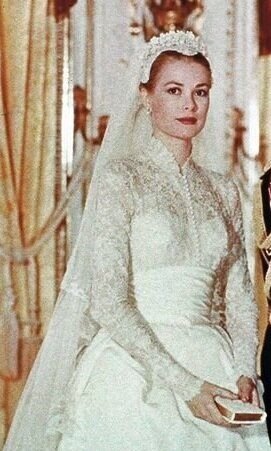
View fullsize
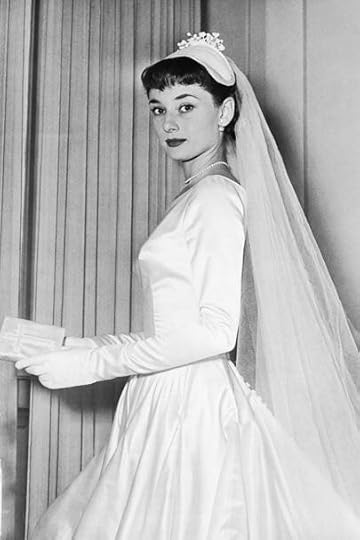
The king’s crown (Cinderella, 1950) ; a modern replica of the Crown of Rus (Ukraine); the Frankfurtian crown of Charles VII
Cinderella at her wedding (1950) ; Grace Kelly at her wedding to Monaco’s Prince Rainier in 1956
The King’s Crown: Although the king doesn’t wear a crown in either the cartoon or live action versions, in the animated version, he does throw his crown out of the window. I managed to get a screenshot of it. It’s notably trimmed in ermine, a fur associated with European royal crowns and robes, but is otherwise pretty unusual, as it features very tall golden spikes, appears to be open to the sky, and is otherwise pretty unadorned (are those rubies around the edge maybe?).
As I mentioned in my first post about Disney crowns, most actual crowns (which remember, are used for coronations and formal ceremonies, as opposed to the the more decorative function of tiaras) these days are closed. Open crowns were much more of a thing in medieval times. If you ignore the padding on the inside, the appearance of the crown bears some similarities to Ukraine’s Crown of Rus, as both feature gold sides ascending into spikes of varying heights. The only gold spiky open crown I could find was the smaller of the imperial coronation crowns of Charles VII (Holy Roman Empire, made in Frankfurter in 1742). The Frankfurter crown is also relatively unadorned with jewels.
Cinderella’s wedding cap: Cinderella (Cartoon) doesn’t wear a tiara in the animated version, but she does have this odd headband/cap thing on her head, which honestly looks more like the juliet caps of the 1950s, as seen on Grace Kelly, more than any sort of tiara. This makes sense, as Disney is known for using a lot of modern clothing elements (modern meaning the years in which the film was developed and released), so the use of a 50s style wedding headdress and dress silhouette is totally on brand for them.
View fullsize
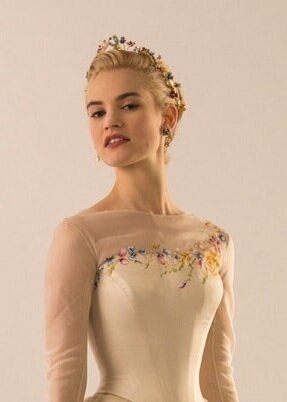
View fullsize
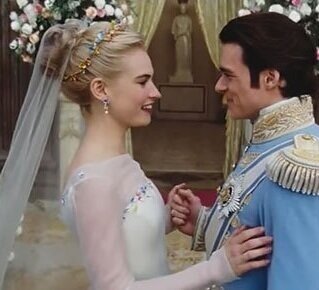
View fullsize
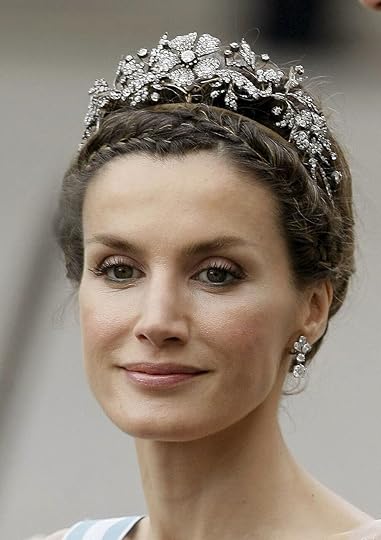
View fullsize
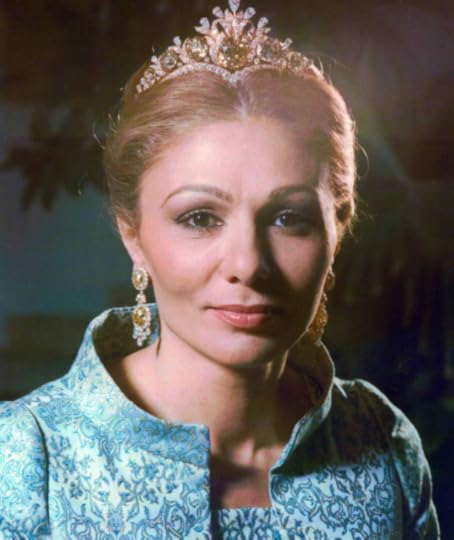
Cinderella’s wedding outfit (2015) ; Cinderella with her prince (2015); Queen Letizia’s floral tiara (created 1879, Queen Letizia of Spain); Empress Farah Pahlavi’s floral tiara (unknown date of creation, but worn in the 1970s, Empress of Iran)
Cinderella (Live action) - The gold, brightly colored floral tiara that Cinderella wears in the live action version has a few real life counterparts. It reminds me a bit of maybe queen Letizia floral tiara or Empress Farah Pahlavi’s floral tiara.
View fullsize
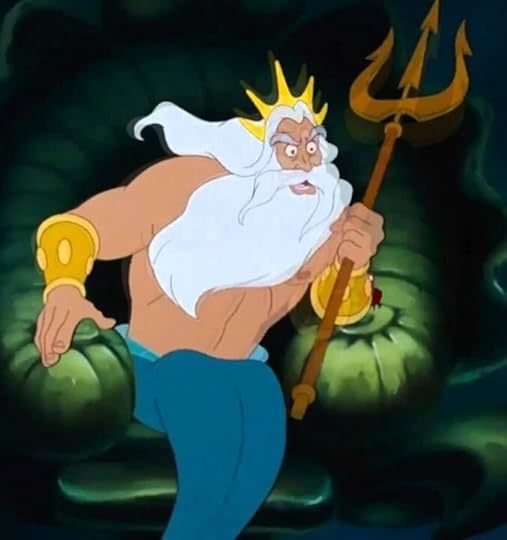
View fullsize
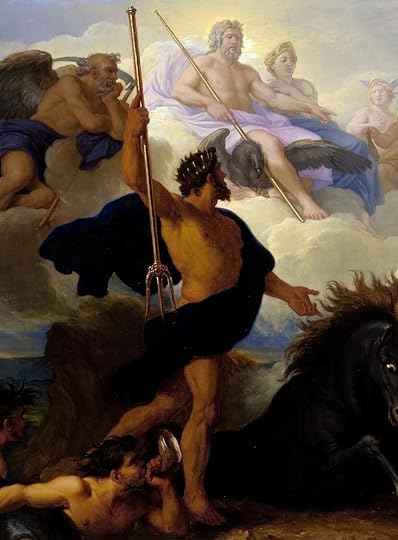
View fullsize
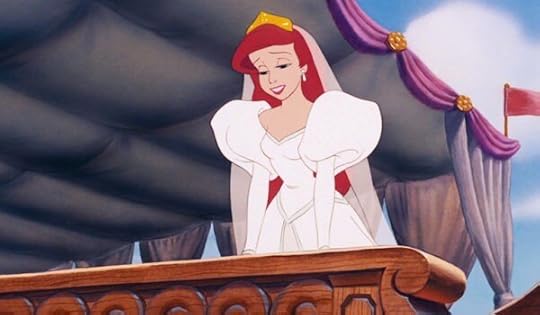
View fullsize
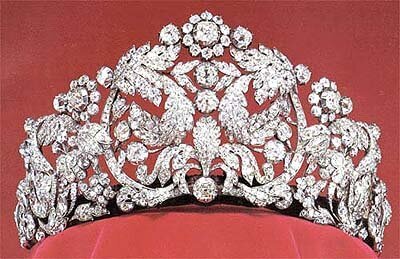
View fullsize
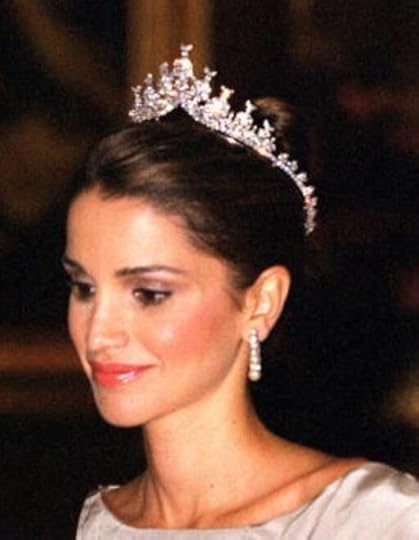
View fullsize
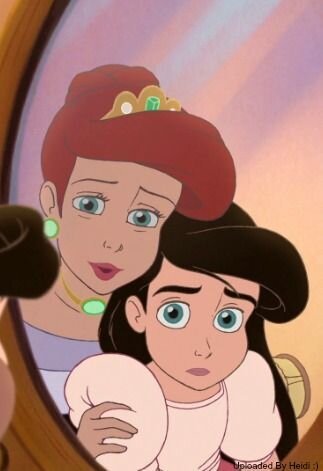
View fullsize
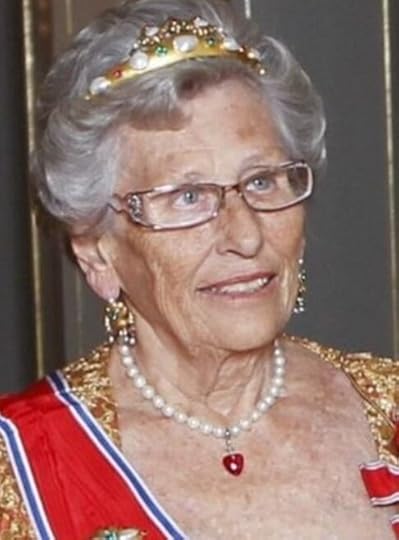
View fullsize
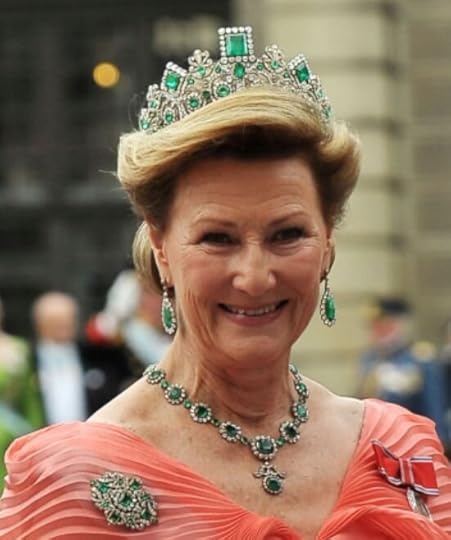
View fullsize
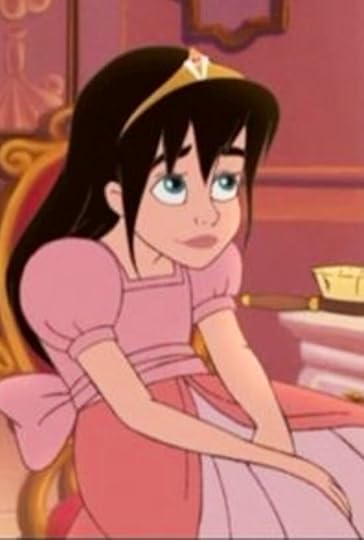
View fullsize
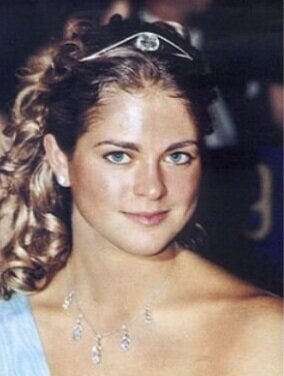
King Triton (The Little Mermaid, 1989), Detail from Dispute between Minerva and Neptune over the Naming of the City of Athens by René-Antoine Houasse, c. 1689-1706
Ariel at her wedding (1989), the Braganza Tiara - 1829, Queen Rania’s diamond tiara (Rania of Jordan, unclear where or when tiara was made) ,
Ariel and her daughter Melody (The Little Mermaid II: Return to the Sea, 2000), Princess Astrid of Norway wearing the Norwegian Gold Bandeau (possibly inherited from Princess Ingeborg of Sweden); Queen Sonja of Norway wearing the Norwegian Emerald Parure (possibly dating back to the 1820s-1830s)
Melody (2000); Madeleine, Princess of Sweden, wearing her Aquamarine bandeau
King Triton’s crown doesn’t look like any crown I’ve ever seen, but I believe it’s supposed to be different because he’s an underwater king. It looks like it’s supposed to emulate coral, not metal, and seems to echo the spikes of Triton’s trident, rather than any crown. I checked to see if his crown looks anything like traditional depictions of Poseidon. I only found one depiction of Poseidon/Neptune that looked anything like this. For the most part, statuary and paintings of Poseidon’s crown do /not/ look like Triton’s crown, but I did find one painting that has a crown with some similarities - Dispute between Minerva and Neptune over the Naming of the City of Athens by René-Antoine Houasse. The painting’s crown appears to go all the way around Poseidon’s head though, while Disney Trident’s crown appears to sit on the front of his head only. Note: Triton sports the same long hair and beard that Poseidon usually sports (although Triton’s is more extreme). Fun fact: Triton in Greek mythology is the son of Poseidon and is usually represented as a merman (and looks nothing like the disney character).
Ariel’s wedding tiara greatly resembles Aurora’s tiara from Sleeping Beauty, which I talked about previously. As I said then, “I couldn’t find any plain gold tiaras in this shape, but I did find a few modern silver and diamond that resemble it, such as the Braganza Tiara and Queen Rania’s Diamond Tiara. “
Ariel sporting an emerald tiara and jewelry set in Little Mermaid 2 - This tiara reminds me a lot of the Norwegian gold bandeau, which is primarily gold and studded with white, green, and red stones. I really haven’t seen many tiaras with white stones in them at all, much less matched with green, so I was pretty excited to see such a close match to Ariel’s crown. Also, with her matching crown, earrings, and necklace, Ariel is actually wearing a parure, which is a jewelry set all intended to be worn together. I’ve included a picture of the Norwegian Emerald Parure to demonstrate what a full emerald jewelry set looks like in real life.
Princess Melody’s tiny tiara most resembles Princess Madeleine of Sweden’s aquamarine bandeau. This tiara, which some have dubbed “the cyclops” has a very simple design, and was assumed to be modern for a long time, but actually goes back several generations, possibly to the art deco period.
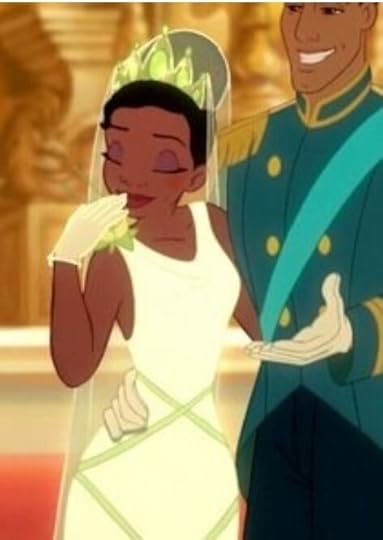
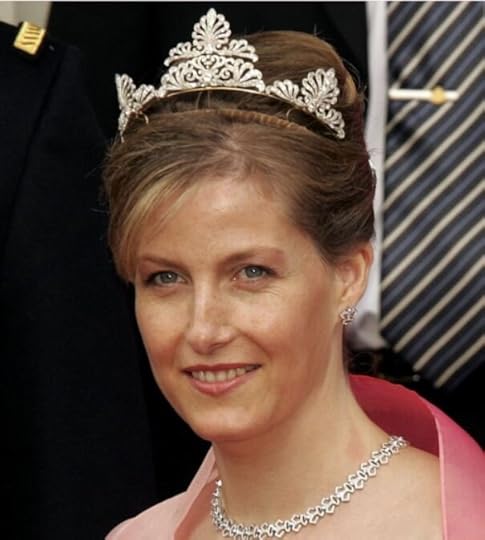
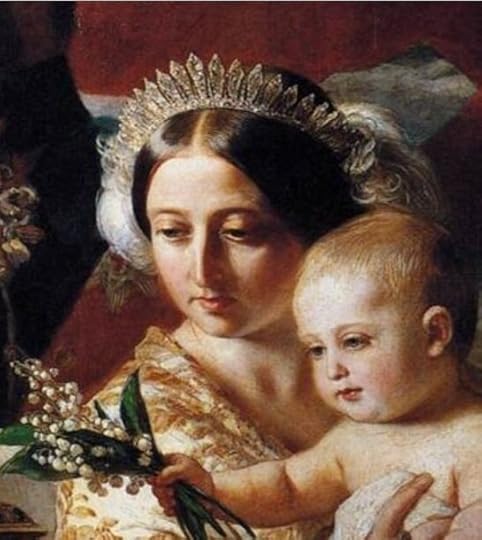
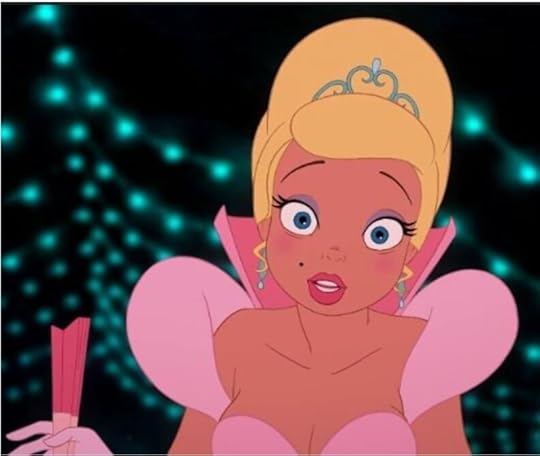
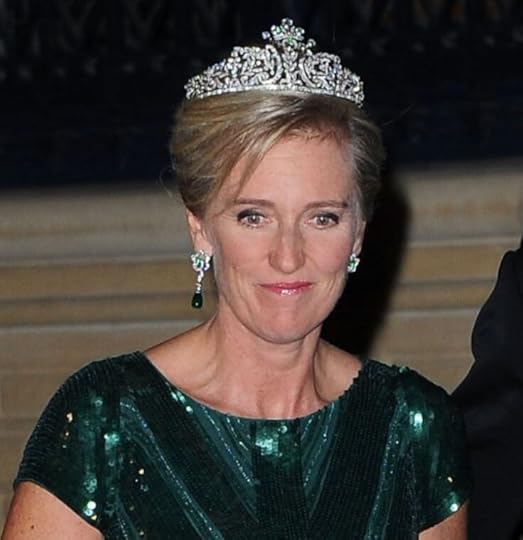
Tiana (The Princess and The Frog, 2009) , Sophie, Countess of Wessex, wearing her Wedding Tiara (1999); a painting of Queen Victoria wearing Queen Adelaide’s fringe tiara (England, 1831)
Lottie (2009); Princess Madeleine of Sweden wearing her aquamarine bandeau (made for her in 2000 for her 18th birthday), Princess Astrid of Belgium wearing the Savoy Aosta Tiara (~1920s France)
Tiana’s wedding tiara has an unusual design that reminds me more of lilly pads than most crowns, but it does have some resemblance to the wedding tiara of Sophie, Countess of Wessex, and a depiction of Queen Victoria wearing Queen Adelaide’s fringe tiara (the fringe tiara looks a little different today, more narrow and with the diamond fringe cutting closer to the head - I’m not sure if that’s because of the painter’s interpretation of the tiara or if the tiara has been reset over time into a different shape).
Charlotte “Lottie” wears a very simple looking tiara that reminds me a bit of the Savoy-Aosta tiara in shape, but also definitely reminds me of Princess Madeleine’s aquamarine bandeau, which I included in the previous section on Princess Melody’s tiara in Little Mermaid 2.
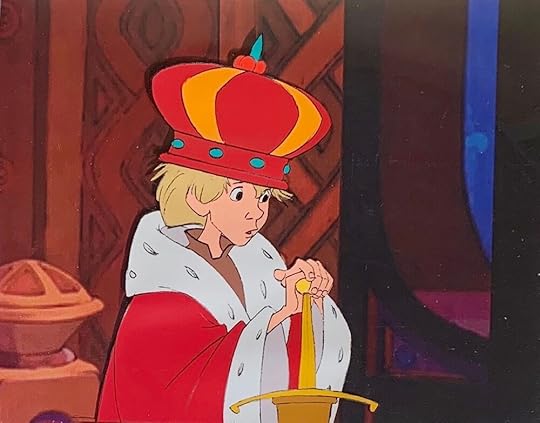
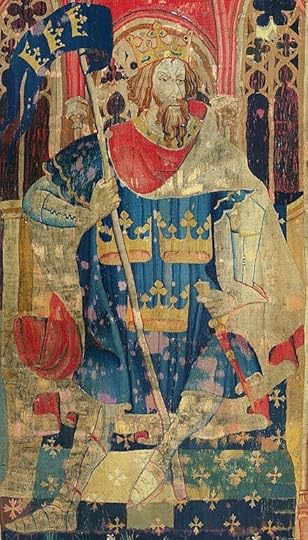
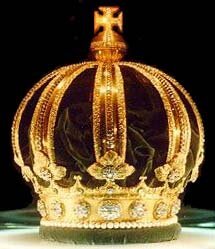
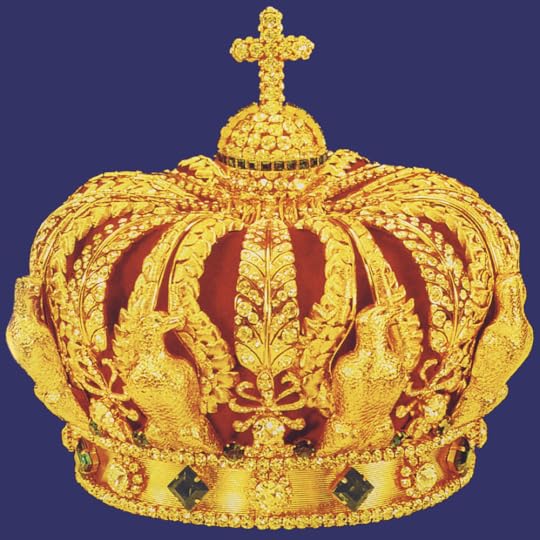

Arthur (The Sword in the Stone, 1963), the Imperial Crown of Brazil (made in Rio de Janeiro in 1841), or Napoleon iii’s crown (made in 1855 in Paris and sold in 1885 by the Third Republic, this photo is a reproduction), Crown of queen Elisabeta of Romania (made in 1881)
Arthur’s crown in The Sword in the Stone is surprisingly modern for a film set in medieval England, as medieval kings tended to have crowns open to the sky rather than this covered crown with big imperial semi-arches Arthur is wearing here. See: the tapestry from c. 1385 depicting what King Arthur’s crown actually would have looked like (if he even existed). I think they chose this crown design more to emphasize how young and small Arthur is rather than to depict anything resembling historically accurate. Sidenote: a crown like this is very heavy and would DEFINITELY only be worn for ceremonial occasions and only a brief amount of time.
The crown reminds me greatly of the Imperial Crown of Brazil, Napoleon III’s crown, or Queen Elizabeta of Romania’s crown. You can see the resemblance in the shape, colors, and the lines of jewels along the base of the crown. All three of these crowns date to the 1800s. The legend of King Arthur goes back to the 500s or so, and the Sword in the Stone film is set in 1200s-1300s ish.



